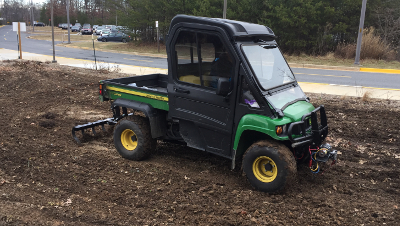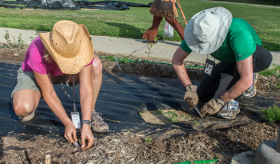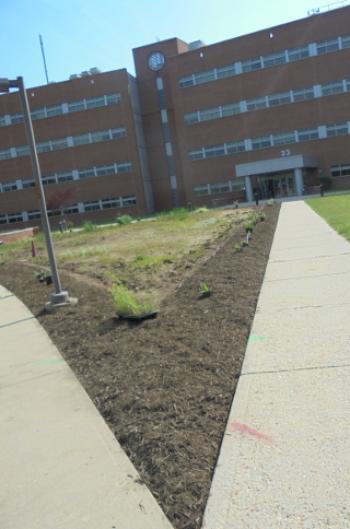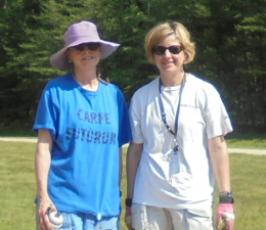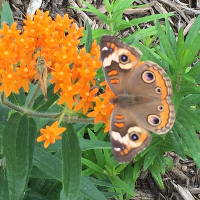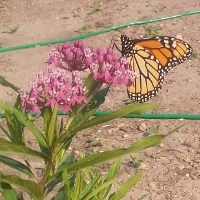B33 Meadow Demonstration Project | National Aeronautics and Space Administration (nasa.gov)
- Introduction
- Current Status & Meadow-Morphosis History
- A Call to Support Sustainability & Diversity
- Native Meadows: The Best "Lawn"
- Partnership
- Employee Photos
- FAQ
Introduction
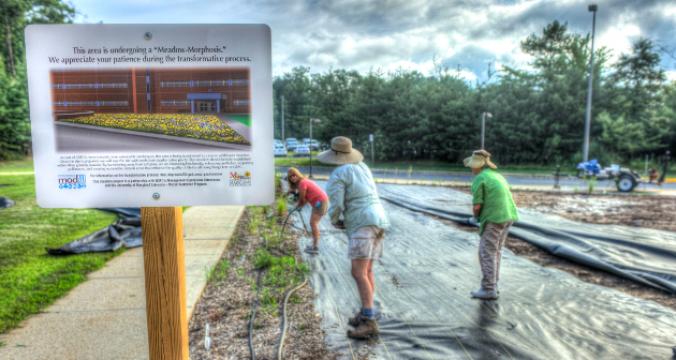
Meadow in transition - removing the plastic groundcover
In 2015, budget cuts forced some difficult decisions in terms of landscaping, with planting beds being removed in favor of larger expanses of turf grass. One such location was a small 0.1-acre area directly in front of the main entrance to the Earth Sciences Building 33. The existing vegetation was removed in the fall in preparation for seeding with grass the following spring.
However, Goddard's Environmental Management team saw this as an opportunity to explore different, more sustainable landscape options that could also meet current budget demands. The Earth Sciences Division, too, saw this as an opportunity to reflect the Division's values. Consistent with their study of the Earth, they sought a landscape that was natural, low maintenance, and ecologically sound. Thus, the meadow demonstration project was born.
That initial 0.1-acre plot has proven to be beautiful, productive, and low maintenance. As a result, we have added additional meadow areas through a partnership with the USDA/Natural Resources Conservation Service. Our federal neighbors to the north, located at the Plant Materials Center, are in search of a method by landowners can convert areas of turf grass to meadow. Our Greenbelt campus is the perfect spot to experiment as we have plenty of turf we would love to convert to meadow. Each new area incorporates a slight tweak in the method. It could be a different approach for removing the existing vegetation (tilling, smothering), a change in the time of year (spring, early summer, or fall), seed versus plugs, etc. Each tweak produces results we study and brings us closer to perfecting the technique. It also results in more meadow on Center, and the multitude of benefits that come with it. For more details on this years-long process, keep reading below.
Current Status & Meadow-Morphosis History
June 22, 2023: Despite the drought, things are still growing.
| We’ve had a very dry stretch here in Greenbelt. This week was the first measurable rain we’ve had in what seems like a couple of months. This had us a bit concerned about our recent teff plantings at buildings 33 and 34. But, as you can see from the pictures, the teff has seemed to weather (pun most definitely intended!) the drought just fine! Both areas have a beautiful, lush carpet of bright green taking hold, which is precisely what we were hoping for. The dense vegetation is keeping invading weeds at bay, which should make for optimal site conditions for later when we put in our native grasses and wildflowers. |
| And our more established areas have performed extremely well under these dry conditions. This is just one of the beautiful things about native plants! They are accustomed to the local climate and soils and can better handle the stresses than plants from another locale. Just look at this gorgeous shot of the area near the H-wing of building 33. Is there anyone who would rather see turf grass than this beautiful, vibrant landscape? WOW! | |
| Finishing up the latest area at B33 |
Our newest additions are coming along! Another small area (roughly 0.1 acres) at building 33 and then a much larger 1.3-acre site near building 34 were tilled and seeded with teff as the first step. We will allow the teff to grow the entire summer, when it should outcompete any weeds that may crop up. In winter, we’ll do a dormant seeding of native grasses and wildflower seed. Exposure to the elements will force the seed to break dormancy in the spring and the teff should create a nice sort of mulch. While this approach of using teff to serve as a nurse crop / weed suppressant has been extremely successful, we continue to tinker with the timing of things, as well as the use of seed versus plugs to determine which process produces optimal results. |
Tilling the large area near the building 34 parking lot.
May 16, 2023: Let’s celebrate – it’s Meadow Day!
What is Meadow Day, you ask? No, you won’t find it among the list of federal holidays and we’re pretty sure you can’t even buy a card for it at your favorite store. No, Meadow Day is all about setting aside a day to celebrate the victories we’ve had with bringing these beautiful areas to campus and sharing some of the lessons learned with a few of our neighbors.
We initially thought this would be more of an internal celebration, having our partners, USDA/NRCS and the USGS/Native Been Lab, out and available to chat with employees who were interested in learning more. However, word of our meadow work has gotten around, and we soon had several Federal neighbors asking if they, too, could join us for Meadow Day. In the end, we had folks from: FDA/White Oak, Fort Meade, Joint Base Andrews, Naval Research Laboratory, USFWS/Chesapeake Bay Field Office, and UMD/Extension Service. These facilities are all interested in converting turf to meadow and were excited to see examples of the practice and learn more about the techniques used here. It was also an excellent networking opportunity to bring together various natural resources managers from different agencies in the area.
Apr 25, 2023: Meadow – Coming to a building near you?
We’re branching out! The higher-ups here at Greenbelt are tuning in to what we’ve been doing and apparently want to do more! They’re looking for areas where the Center can reduce turf grass and the associated maintenance of mowing. While our efforts thus far have been focused around building 33, now we’re moving up to building 34 and the big area of turf grass adjacent to the parking lot is slated for conversion to meadow. We’ll again be enlisting the help of our federal neighbors to the north, USDA’s Natural Resources Conservation Service. This will be the largest area we’ve tackled yet – 1.3 acres – but we’re excited to create even more critical habitat for our pollinators and other local wildlife.
November 17, 2022: The meadow is slowing down.
As the days grow shorter and colder, the meadows are winding down and preparing for sleep. The teff grass, lush and green in summer, has started to wane, now a pale straw color and without its original vigor. Yet, the last holdouts remain. The beautiful purple mist flower can still be seen and serves as a reminder that the vibrancy of the meadow is still there, though swaddled in its winter blanket.
October 19, 2022: Hurray for the H-wing!
|
August planting at H-wing |
Final round of planting in October |
Our newest meadow area, the H-wing of building 33, had its final planting day today. This was a multi-step process, with initial planting happening in late-August, then this final round today. This area presented some real challenges with its steep slopes and large patches of Miscanthus, a non-native, highly invasive ornamental grass. We needed to remove these large grasses from the area as their seed is easily spread by the wind in the fall and would quickly outcompete many of our natives. Smothering with the plastic landscape fabric worked remarkably well and we plan to use this technique for additional infestations in the future.
July 7, 2022: It’s planting day!
The combined NASA and USDA/NRCS team put in a hard day’s work! After removing the landscape fabric, we added hundreds of plugs to the area along the 32/33 pathway. Seed for teff grass was also scattered about, to again serve as a nurse plant and weed suppression for our tender little native seedlings.
We also took this opportunity to begin preparations on our NEXT meadow area, near the east side of the building (H-wing). We simply moved the landscape fabric down to the new location and put it in place along the edges, while the central portion of the area was tilled and planted with teff grass.
March 31, 2022 – New meadow in the works.
Having already converted the grassy area on the north side of the walkway between buildings 32 and 33, we’re now planning to work on the south side. We’re using the same plastic landscape fabric that we used way back in 2016 with our initial meadow to smother the current vegetation here. And, we have plant plugs growing away at the NRCS greenhouse, that will be ready for planting when it’s time to remove the plastic.
August 19, 2021: Measuring Success, One Transect at a Time
NRCS Scientists conducting species survey
Our newest meadow, installed in partnership with USDA/NRCS, is doing quite well. The native wildflower and grass plugs we planted in the spring are busy putting down roots and establishing themselves. This is made possible by the teff grass surrounding them and suppressing unwanted plant species that could take over the area. Using teff as a “nurse” species is a relatively new technique for USDA/NRCS, and they wanted to quantitatively determine the effectiveness of the teff. Here (picture at left), two of the NRCS scientists walk transects across the meadow. A string is marked with a spot at one-foot intervals, and the scientist looks directly beneath and notes which plant species is present. By doing several of these survey transects, they can collect data to determine what percent of the meadow is made up of teff, the native plugged species, or something else entirely. Preliminary data suggest a very high success rate, with greater than 85% of the species either the teff or the native plugs!
Looking east in the new meadow
If this pilot meadow is successful, NRCS hopes to test out the technique on an even larger plot of land, perhaps here at Goddard. The hope is that this method can eventually become a best management practice (BMP) that USDA/NRCS advertises to farmers or other landowners who have available plots of land with which they could increase conservation and promote land stewardship. We’re happy to have GSFC be part of the test bed, helping our Federal neighbors with research activities, while also making our Center a more sustainable and ecologically beneficial landscape.
While we were out there, we also did a quick checkup on the original meadow, just to see how things were going. Well, there sure is a lot of activity going on these days! We found this very nicely camouflaged praying mantis hiding out on the swamp milkweed. That green coloring sure made him hard to spot! We also found a Monarch butterfly egg on the underside of common milkweed. The richness of species present in the meadow is very rewarding, knowing that we had a hand in creating the space where these wonderful species could live and thrive.
|
Monarch egg on common milkweed |
June 6, 2020: Pollinator Week is coming up soon – who’s visiting now?
|
Pollinator Week is right around the corner, June 22-28, so we decided to pop on over to the meadow to see who is visiting now. Interestingly enough, the dragonflies and damselflies were the only ones to be found. At left is the common green darner, while below (left to right) are the Eastern Amberwing, common whitetail skimmer, and azure bluet. We’re not sure where all the bees and butterflies were (social distancing, perhaps?), but hopefully they’ll be around in a few weeks to help celebrate Pollinator Week in the meadow. |
April 28, 2020: The meadow in the time of COVID-19
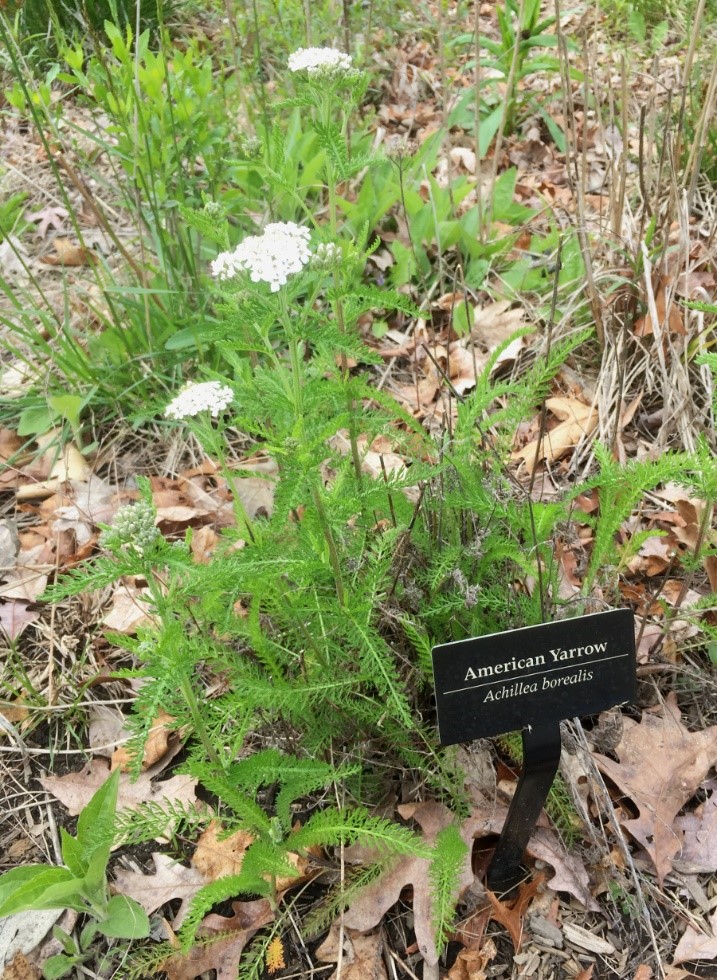 It is a surreal time we are currently living through. The entire world is in the grips of a global pandemic and Goddard is not immune (no pun intended!) to the effects. While on Center to pick up teleworking equipment, I took a quick drive by of the meadow so that I could post this update. I’m happy to report that the meadow appears to be none the worse for wear. As with many locations across the globe, nature is flourishing in the absence of humans.
It is a surreal time we are currently living through. The entire world is in the grips of a global pandemic and Goddard is not immune (no pun intended!) to the effects. While on Center to pick up teleworking equipment, I took a quick drive by of the meadow so that I could post this update. I’m happy to report that the meadow appears to be none the worse for wear. As with many locations across the globe, nature is flourishing in the absence of humans.
As famed biologist E.O. Wilson stated in his 1987 paper, “The Little Things That Run the World,” nature carries on just fine when humans are removed. Our meadow is evidence of that. Spring has sprung and several species are beginning to take off. The beautiful yarrow is in bloom (left), the path rush has exploded in growth due to all the rain we’ve seen (below) , and the narrow-leaf mountain mint is pushing out into new areas. While we humans shelter in place and keep our social distance, the species in the meadow are mingling and thriving. It’s evidence that life does indeed carry on.
I find the resilience of nature reassuring, and hopeful. During this time of uncertainty and fear, go out and find your own little patch of nature. Observe for yourself those flowers just starting to bloom or the early pollinators out on a foraging mission. Bask in the warmth of the sun shining overhead; breathe in the fresh air all around you. Soak in all that nature has to offer, and appreciate its power to carry on. Then, remember, that we too are part of nature, with the same strength and resilience to push through this trying time.
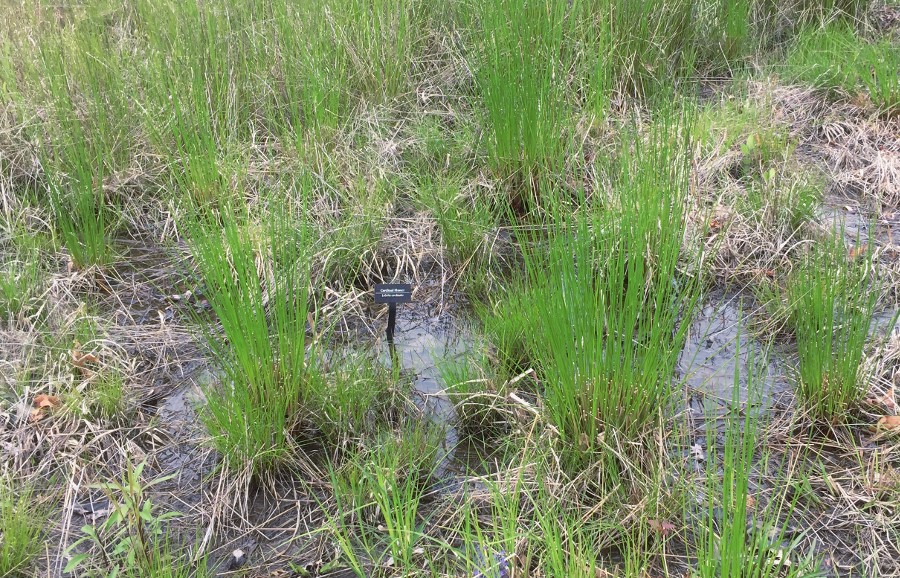
March 12, 2020: Spring Cleaning
The weather has started to warm which has us thinking about spring. And, with spring comes spring cleaning! For the meadow, this means cutting vegetation back to the ground and hauling some of it off site. Performing this process on a yearly or every other year cycle mimics the type of disturbance that causes meadows in our part of the world. Since we live in the Eastern Deciduous Forest, we would normally expect to have wooded areas. However, disturbances such as lightning strikes, wind storms, fires, or in our case, cutting with shears, keeps the landscape from undergoing succession to a forest state. In so doing, we are able to create the additional habitat type of meadow here at Goddard, and the bees, butterflies and other pollinators sure are happy that we do!
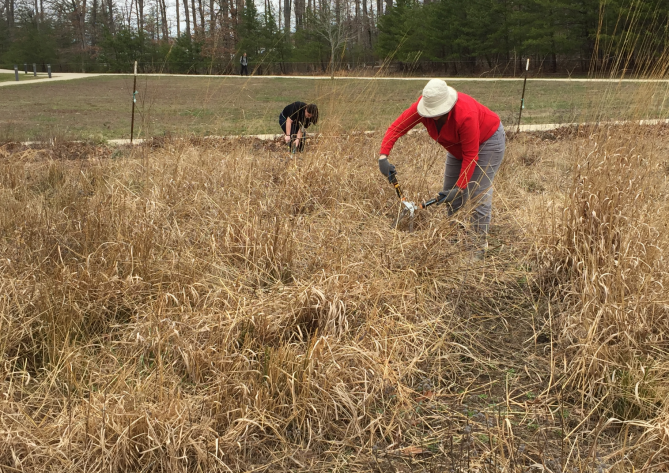
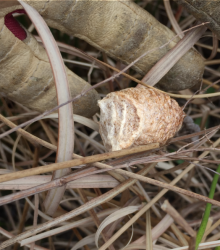 During the clean up, we also spotted evidence of last year’s residents. We found several (probably dozens!) of these little things -- egg cases of the Chinese Praying Mantis (see photo at right, with gloved hand for size comparison). These egg cases were attached to the twigs and stalks of vegetation, and we had to be careful when cutting things back. With this many egg cases, it seems to indicate that there was plenty of prey for our praying mantids to feast upon – a wonderful sign of the life and biodiversity hosted in the meadow.
During the clean up, we also spotted evidence of last year’s residents. We found several (probably dozens!) of these little things -- egg cases of the Chinese Praying Mantis (see photo at right, with gloved hand for size comparison). These egg cases were attached to the twigs and stalks of vegetation, and we had to be careful when cutting things back. With this many egg cases, it seems to indicate that there was plenty of prey for our praying mantids to feast upon – a wonderful sign of the life and biodiversity hosted in the meadow.
October 30, 2019: Sharing our story with other Feds
We recently presented at the Federal Environmental Symposium (FES), hosted at the National Institutes of Health (NIH) in Bethesda, MD. Our talk was entitled, "Meadows: The Smart, Sustainable Alternative to Turf Grass,” which covered our little meadow and its many benefits over the more traditional practice of landscaping with lawn. We had a nice-sized crowd in attendance and many good follow-up questions were posed. We’re hoping the success we’ve seen with the meadow can be replicated at many other Federal campuses throughout the region!


October 9, 2019: Local Meadow Experts Gather at GSFC
Goddard hosted a workshop for local meadow experts. Organized by our wonderful native plant expert, Dr. Sara Tangren (see photo just below) and the Universtity of Maryland Extension, this meeting brought together folks from all different sectors including non-profits, academia, utilities, state and federal government, etc. The focus of the meeting was to identify current barriers to using meadow and similar conservation landscapes over traditional turf grass. We also discussed how these barriers might be overcome and where we would like to see the field go in the future. There was also a tour of Goddard's own meadow in front of building 33. It was great to have everyone come together to work on common problems and help come up with potential solutions!
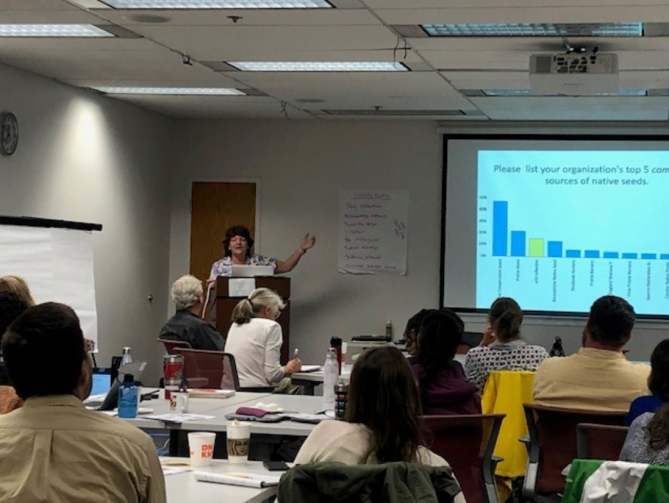

July 25, 2019: It’s definitely butterfly season.
Forget the “dog days” of summer… these are the butterfly days! We stopped by the meadow to restring our perimeter deer fence, and while we were there, we couldn’t help but notice all the beautiful butterflies! And, we weren’t the only ones noticiing. So many folks on their way in or out of the building stopped and took a long look in the meadow, with several capturing some shots with their phones. What a treat to be able to marvel at these beautiful little wonders of nature, all while at work.
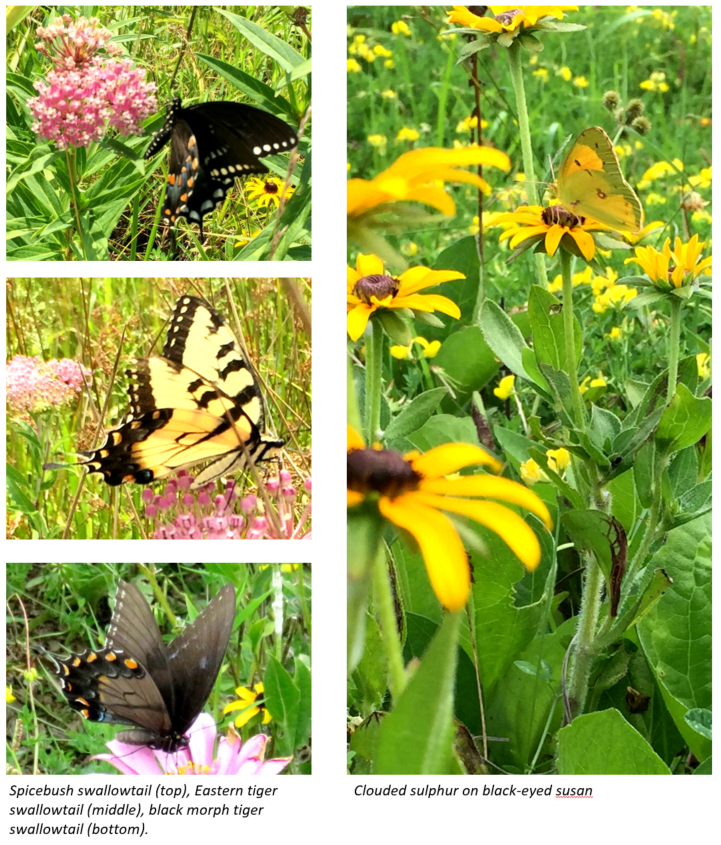
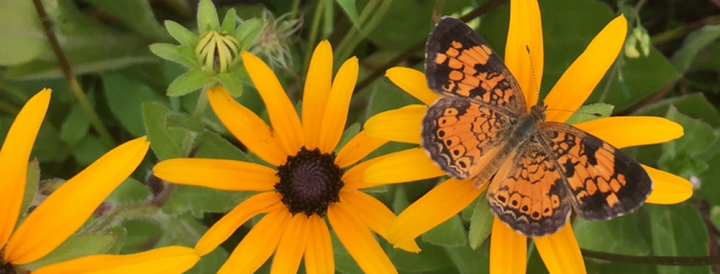
Pearl Crescent on black-eyed susan
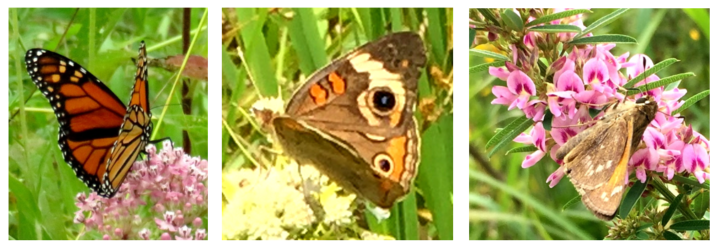
Monarch (left), common buckeye (middle) and skipper (right).
July 3, 2019: I saw the (new) signs!
Have you noticed the updated signs at the meadow? Since we’re now in the meadow’s third growing season, and it’s come a long way, we thought it was time to update the signage to reflect the progress. Come out and take a look!

July 1, 2019: The meadow is abuzz with visitors!
We were out and about this week, just taking stock of the meadow. What plants were up and blooming? Which insects were visiting? The answers to these questions reveal a thriving, diverse ecosystem. Here are just a few of our observations!

June 20, 2019: What will Pollinator Week bring this year?
This week is one of our favorite times in the meadow, National Pollinator Week! This year, Pollinator Week runs from June 17-23 and is a time to celebrate our pollinators and spread the word about what we can all do to protect them. One of the most important things we can do is to increase the amount valuable habitat available to pollinators. Here at Goddard, we’ve added some critical habitat in this meadow, and we hope you’ll bring those concepts home and create a a home for pollinators in your own yard.
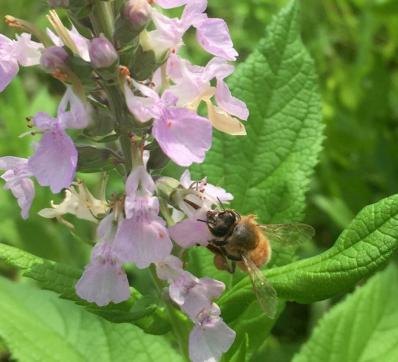

To honor Pollinator Week, we went looking in the meadow to see who was visiting. As we normally do, we saw many a bee, butterfly and beetle. We saw this cute little honey bee (left) enjoying the flowers of American Germander. After a bit more hunting, we then happened upon the gorgeous Pandorus Sphinx Moth (right). It sure seems that the word is getting out… pollinators welcome at GSFC!
June 11, 2019: Pretty yellow flowers? Looks can be deceiving.
Have you walked by the meadow lately and thought, “Wow, what a pretty yellow flower. And, oh my, it’s everywhere!”
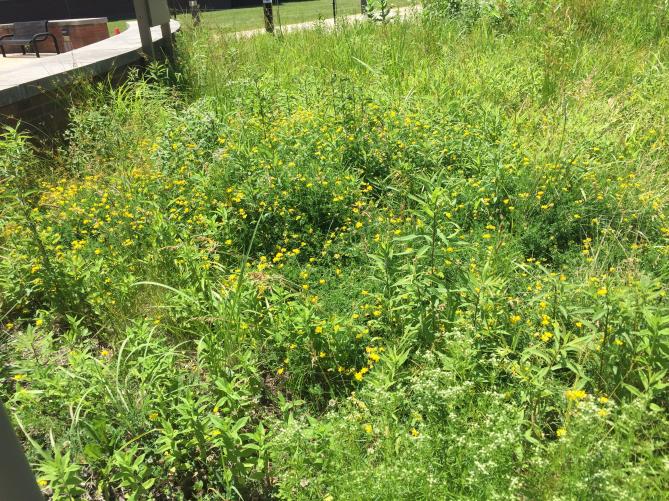
If so, you were seeing the latest plant on our most wanted list, Birdsfoot Trefoil. This is currently in bloom and can be seen throughout the meadow. (Of note, anytime you see a plant everywhere, your Spidey sense should tell you that it may just be an invasive weed.) We’ve been battling this formiddable foe for three seasons now – it’s putting up quite a fight! We removed the majority of these pesky plants, but we’re likely to see more crop up throughout the growing season. The fight continues.
May 21, 2019: Flowers are in bloom
The meadow has taken off in recent weeks. One of the first plants to bloom is hairy beardtongue (picture below left). With few other sources of nectar so early in the season, this plant is a favorite of pollinators and a wonderful addition to the meadow or a home garden.
Also spotted were the beautiful yellows and blues of these two beauties (below). The ragwort (not to be confused with ragweed) is another early bloomer that pollinators depend on. The sweet blue flowers of the blue-eyed grass are a welcome volunteer, having come in on their own to the meadow.
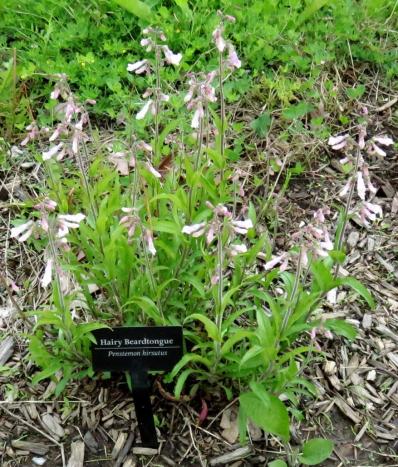
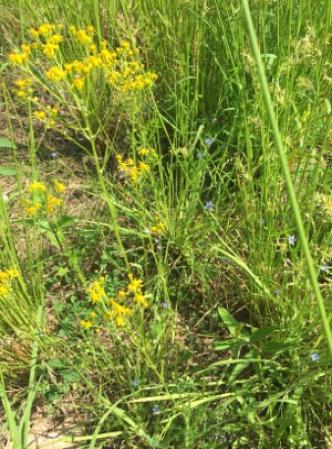
April 9, 2019: Spring Cleaning
After weed whacking the meadow, we ended up with a lot more thatch than anticipated. While we had originally planned to leave all of this plant material to break down and provide a natural mulch, we quickly realized that the sheer volume of material was inhibiting our little seedlings from soaking in the warming rays of the sun. Therefore, we decided to move away a good deal of this material.

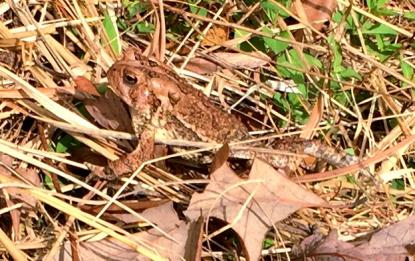
In the process, we came across some really neat finds! While moving leaves from the edge of the meadow, this little snake (nicely camouflaged in the picture above left) caused a bit of a startle! Not much bigger than a large worm, this Eastern Smooth Earthsnake is actually a rather uncommon snake to see as they spend most of their time underground. We also happened upon another well-camouflaged animal in all the thatch. This Fowler’s Toad (above right) is common throughout Maryland and found in fields like our meadow, as well as other habitats. While the birds, bees and butterflies are plain to see, if you look a bit closer, the meadow is home to many wonderful creatures.
February 28, 2019: Baby's First Haircut
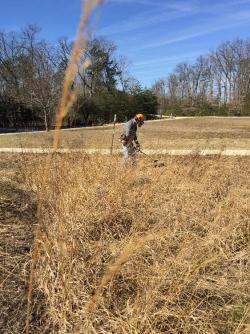 We’re coming up on growing season number three for our little meadow. It’s been fascinating to see the changes, even between the first two years of growth. Species that were shy little wall flowers the first year popped out to become superstars the second year (yes, Indiangrass, we’re talking about you). With all that growth through the first two years, it was time to give our little baby its first haircut, or in this case, its first weed whacking.
We’re coming up on growing season number three for our little meadow. It’s been fascinating to see the changes, even between the first two years of growth. Species that were shy little wall flowers the first year popped out to become superstars the second year (yes, Indiangrass, we’re talking about you). With all that growth through the first two years, it was time to give our little baby its first haircut, or in this case, its first weed whacking.
This is standard maintenance for meadows. Remember that meadows are a temporary biome in our neck of the woods, the Eastern deciduous forest. If left to its own devices, this area would all be nothing but woods. In order to maintain meadow, we need to halt the natural process of succession, cutting back all emergent woody vegetation (trees and shrubs). Also, cutting back our native wildflowers and grasses will help them to be more vigorous this next growing season. The timing of the mowing is particularly important. Late winter or early spring is the perfect time to perform this maintenance. This timing allows overwintering critters such as insects or birds to move out as weather starts to warm up, but also precedes the emergence of new spring growth. We have left the mowed vegetation in place as it will naturally break down to provide nutrients and cover for our tender meadow plants over the next several weeks.

October 18, 2018: The Golden Glow of Autumn
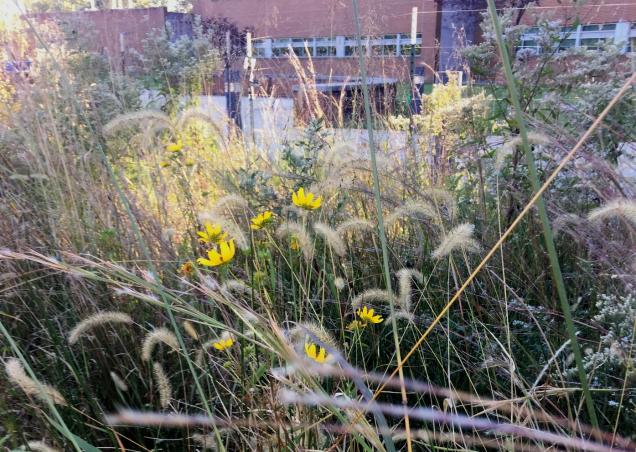
The meadow at this time of year is simply enchanting. The flurry of activity during the height of summer has subsided. The crickets are still chirping and whirring, and dragonflies buzz about in the afternoon sun, but the frenzied flights of bees and butterflies have passed. So, too, have the colors undergone a change. The bright pinks and oranges of summer have given way to the muted tones of gold and amber. The sun now sets lower and lower in the sky. As the last rays of afternoon sun pass over the meadow, they illuminate the gently swaying grasses, their fuzzy heads having an ethereal glow to them. The meadow certainly has a different feel to it, though it is still breathtaking. It allows you to see first-hand the ebb and flow of nature, and makes you appreciate the beauty it offers all year round.
October 10, 2018: Some Late Additions
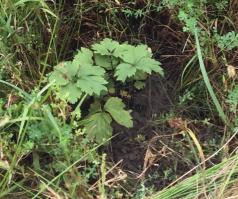 Although the growing season is nearly done, we’ve decided to do a little fall planting – actually the perfect time to make additions. An enthusiastic employee has given us a few Thimbleweed (Anemone virginiana, see photo at right) plants to try out in the meadow. We’re hopeful these will provide a few extra blooms in the meadow early next summer!
Although the growing season is nearly done, we’ve decided to do a little fall planting – actually the perfect time to make additions. An enthusiastic employee has given us a few Thimbleweed (Anemone virginiana, see photo at right) plants to try out in the meadow. We’re hopeful these will provide a few extra blooms in the meadow early next summer!
We also have some areas in the meadow that are still lagging behind in terms of supporting a rich diversity of plants. These areas likely have some difficult site conditions that are making it hard for plants to become established, such as being extremely compacted, having high salt content due to proximity to sidewalks, exhibiting high pH, or several other possibilities. Therefore, these areas have recently received a bit of extra TLC to try and get them up to speed. 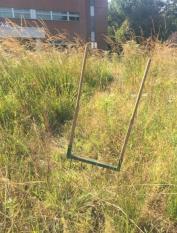
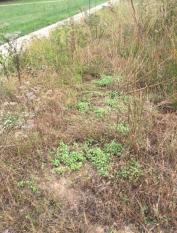 We began with using a broadfork to open the soil a bit more. A broadfork (see photo at left) is a lot like a pitchfork, but well, broader! It deeply aerates the soil while still preserving the soil structure, thus minimizing weed seed surfacing – very important in an area such as ours where we have no shortage of weed seeds just waiting for the opportunity to rear their ugly heads. With the soil nicely opened up, we then introduced our favorite tillage radish seeds yet again this year. If soil compaction is the problem, we’re hopeful the combination of broadforking and radishes will go a long way to breaking up the soil at depth and allowing our native plant roots to take hold and encourage plant growth. In the picture at right, the small bright green plants are the newly emerged tillage radish seedlings. You can almost see precisely where we used the broadfork as the young plants have popped up in exactly the same area.
We began with using a broadfork to open the soil a bit more. A broadfork (see photo at left) is a lot like a pitchfork, but well, broader! It deeply aerates the soil while still preserving the soil structure, thus minimizing weed seed surfacing – very important in an area such as ours where we have no shortage of weed seeds just waiting for the opportunity to rear their ugly heads. With the soil nicely opened up, we then introduced our favorite tillage radish seeds yet again this year. If soil compaction is the problem, we’re hopeful the combination of broadforking and radishes will go a long way to breaking up the soil at depth and allowing our native plant roots to take hold and encourage plant growth. In the picture at right, the small bright green plants are the newly emerged tillage radish seedlings. You can almost see precisely where we used the broadfork as the young plants have popped up in exactly the same area.
October 9, 2018: What’s in the bag?
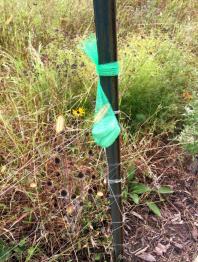 Some of you have probably been wondering, “What the heck is in those green bags in the meadow?” Well, you’re not alone in your curiosity! A few folks have stopped us while we were working out front of B33 to ask just what those bags are for and what’s in them. It’s just the latest attempt to repel the deer. We had heard anecdotal evidence that certain soaps (Irish Spring in particular, though we are not endorsing any one brand!) are really disliked by the deer who then tend to steer clear of areas where the soap is present. We figured, it was worth a shot! So, off to the grocery store to purchase a few bars, then back to the meadow to hang out pieces of the soap in little mesh bags. It’s hard to tell how successful the deterrent has been. While we haven’t seen any fresh evidence of deer, with the vegetation growing up so thick, it would be hard to see any new tracks or other indications. If you see the deer in the meadow, or better yet, see them turning up their noses at the smell of the soap, please let us know!
Some of you have probably been wondering, “What the heck is in those green bags in the meadow?” Well, you’re not alone in your curiosity! A few folks have stopped us while we were working out front of B33 to ask just what those bags are for and what’s in them. It’s just the latest attempt to repel the deer. We had heard anecdotal evidence that certain soaps (Irish Spring in particular, though we are not endorsing any one brand!) are really disliked by the deer who then tend to steer clear of areas where the soap is present. We figured, it was worth a shot! So, off to the grocery store to purchase a few bars, then back to the meadow to hang out pieces of the soap in little mesh bags. It’s hard to tell how successful the deterrent has been. While we haven’t seen any fresh evidence of deer, with the vegetation growing up so thick, it would be hard to see any new tracks or other indications. If you see the deer in the meadow, or better yet, see them turning up their noses at the smell of the soap, please let us know!
September 25, 2018: What IS that grass??
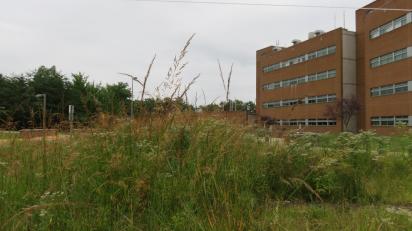 That’s the question we keep getting asked every time folks see us at the meadow. “So, is that grass good?” they ask with a slight wrinkling of the nose. “Did you mean to plant that?” People are really curious about the most obvious plant in the meadow right now. And, the answer to both of those questions is a resounding, YES. The species in question is Indiangrass (Sorghastrum nutans). It’s a native, warm-season grass that is local to our area. It was already present in the meadow last year at this time, but we had much fewer individual plants and those we had were not nearly as prominent. It’s likely the incredible amount of rain we’ve had this growing season, along with the supplemental watering the meadow received during the drought just caused the Indiangrass to grow larger than normal. In fact, examples of this plant we’ve recently seen in the landscape around Goddard (not in the B33 meadow) are not so tall. The meadow this year obviously created ideal conditions and the Indiangrass simply took off!
That’s the question we keep getting asked every time folks see us at the meadow. “So, is that grass good?” they ask with a slight wrinkling of the nose. “Did you mean to plant that?” People are really curious about the most obvious plant in the meadow right now. And, the answer to both of those questions is a resounding, YES. The species in question is Indiangrass (Sorghastrum nutans). It’s a native, warm-season grass that is local to our area. It was already present in the meadow last year at this time, but we had much fewer individual plants and those we had were not nearly as prominent. It’s likely the incredible amount of rain we’ve had this growing season, along with the supplemental watering the meadow received during the drought just caused the Indiangrass to grow larger than normal. In fact, examples of this plant we’ve recently seen in the landscape around Goddard (not in the B33 meadow) are not so tall. The meadow this year obviously created ideal conditions and the Indiangrass simply took off!
September 14, 2018: Summer is winding down - part of the lifecycle
As the days get shorter and cooler, it certainly feels like summer is sneaking out the door. While there’s still activity in the meadow, the frenzied movements of mid-summer bees and butterflies have noticeably slowed. Such is the ebb and flow of life in the meadow. Mother Nature is winding down, readying itself for slumber. However, there are still journeys to be had by some of the occupants in the meadow.
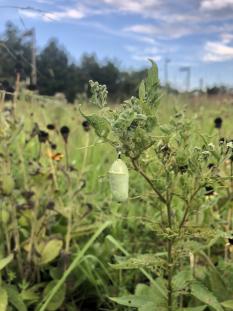 Building 33 employee, Brendan McAndrew, recently spotted this stunning Monarch chrysalis in the meadow. As we all go about our normal routines over the next few days, this chrysalis will be the site of an amazing transformation – the metamorphosis from caterpillar to butterfly unfolding just beneath the brilliant green and gold-flecked surface. Once it emerges, this butterfly will begin the journey of a lifetime. It will travel more than 2000 miles to reach its ultimate destination in the high mountains of Mexico, where it will overwinter with millions of others, stopping only to feed on nectaring flowers along the way.
Building 33 employee, Brendan McAndrew, recently spotted this stunning Monarch chrysalis in the meadow. As we all go about our normal routines over the next few days, this chrysalis will be the site of an amazing transformation – the metamorphosis from caterpillar to butterfly unfolding just beneath the brilliant green and gold-flecked surface. Once it emerges, this butterfly will begin the journey of a lifetime. It will travel more than 2000 miles to reach its ultimate destination in the high mountains of Mexico, where it will overwinter with millions of others, stopping only to feed on nectaring flowers along the way.
Our little meadow has done it again. It has fulfilled its role in this Monarch’s lifecycle. It is home to several of the Monarch hostplant, milkweed, the only species upon which Monarchs will lay their eggs and larvae will feed. It also offered ample habitat, a location where the caterpillar felt comfortable to progress to the next stage and pupate. And, likely, it will also provide the first meal of nectar on which the newly emerged butterfly will feed before it begins its very long journey south. And thus, the life cycle will continue…
August 16, 2018: The meadow is thriving; so, too, are some weeds.
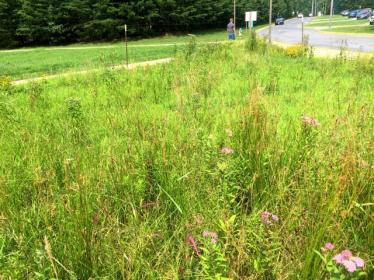 The meadow these days is looking great. It’s managed to thrive in Maryland’s characteristically unpredictable weather this summer, going through monsoon, drought, and once again monsoon. As this picture shows, our water-loving plants are doing particularly well. The pretty, little plant with the pink flowers is swamp milkweed (Asclepias incarnata). As its name suggests, it is only too happy to have “wet feet.” Situated right next to it is path rush (Juncus tenuis), the spiky dark green plant. The center of the meadow is a slight depression in the topography that tends to stay wet even through drier weather and these plants have gravitated toward this area. It just goes to show, a perfect plant (or two) exists for every condition. You just need to find those plants.
The meadow these days is looking great. It’s managed to thrive in Maryland’s characteristically unpredictable weather this summer, going through monsoon, drought, and once again monsoon. As this picture shows, our water-loving plants are doing particularly well. The pretty, little plant with the pink flowers is swamp milkweed (Asclepias incarnata). As its name suggests, it is only too happy to have “wet feet.” Situated right next to it is path rush (Juncus tenuis), the spiky dark green plant. The center of the meadow is a slight depression in the topography that tends to stay wet even through drier weather and these plants have gravitated toward this area. It just goes to show, a perfect plant (or two) exists for every condition. You just need to find those plants.
Sometimes, however, you don’t find the plants, but the plants find you. They get introduced to your site and its conditions, then decide they want to take up residence. When these are “good” plants, it’s a fortuitous accident. But, when these are “bad” plants (aka weeds), then some work needs to be done. The meadow certainly has this situation. Along the border, we’ve had infestations of two particular weeds, Japanese stiltgrass (Microstegium vimineum) and joint grass (Arthraxon hispidus). If left unchecked, these two invaders could leave the meadow in shambles. Thus, we had to get on the offensive and take care of these two thugs before things got out-of-hand. Below, you can see the before and after pictures. With this space now cleared of weeds, more of our good plants will hopefully soon move in. At the very least, we’ve prevented these two invasives from getting a strong foothold in the meadow and potentially doing some major damage.
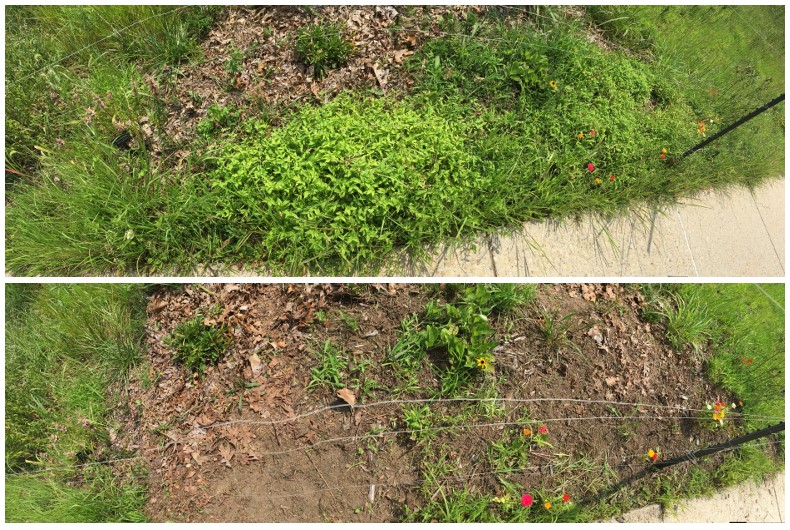
May 30, 2018: Blooms are out, so are the pollinators.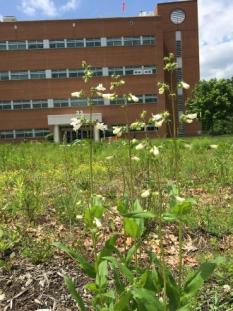
If you haven’t been to the meadow in a while, it’s definitely time to stop by. All of the recent rain and warm weather has led to the start of the blooming season. This past week or so, we’ve seen blue-eyed grass, hairy beardtongue (see photo at right), golden ragwort, and American yarrow displaying their flowers. These are all part of our native plant contingent. Unfortunately, we also have some non-natives, even invasives, in the meadow and in bloom. Included in these are clover, ajuga and buttercups. We continue to work to keep those at bay. You will also notice we have several more species coming up and growing nicely, with their blooms just down the road. This is good news for our pollinators who are in desperate need of nectar sources early in the season. Speaking of pollinators, National Pollinator Week is coming up on June 18-24. This is a time not only to celebrate our pollinators, but also to spread the word about what we all can do to protect them. Brush up on your own knowledge of pollinators and all the ways you can help them by reading the Pollinator Partnerhip’s "Pollinator Fast Facts for Gardeners".
April 19, 2018: It's half-past April....Time to Wake Up!
 Is it really April 19th? It sure felt like January 96th! Conditions at the meadow today were cold, windy, and we were even getting the occasional sprinkle, but smiles could still be found on the faces (see photo) of these in attendance. Why? Because we were back out in the meadow! After a long winter’s nap, the meadow is just now starting to come back to life. The moistest of the areas showed the greenest plants, such as cardinal flower and rushes. But, all areas are starting to show signs of awakening. Unfortunately, this early in the season, much of that awakening is from the weeds. We were attacking some familiar foes - clover, lespedeza, even dandelions. We also were tidying things up along the border, cutting down some of last year’s growth, as well as re-mulching our path to be even more inviting. Early spring flowers such as these violets (see photo) provide a taste of what’s just around the corner. Things are looking in tip-top shape and now we’re just waiting on Mother Nature to bring the warmer weather full-time.
Is it really April 19th? It sure felt like January 96th! Conditions at the meadow today were cold, windy, and we were even getting the occasional sprinkle, but smiles could still be found on the faces (see photo) of these in attendance. Why? Because we were back out in the meadow! After a long winter’s nap, the meadow is just now starting to come back to life. The moistest of the areas showed the greenest plants, such as cardinal flower and rushes. But, all areas are starting to show signs of awakening. Unfortunately, this early in the season, much of that awakening is from the weeds. We were attacking some familiar foes - clover, lespedeza, even dandelions. We also were tidying things up along the border, cutting down some of last year’s growth, as well as re-mulching our path to be even more inviting. Early spring flowers such as these violets (see photo) provide a taste of what’s just around the corner. Things are looking in tip-top shape and now we’re just waiting on Mother Nature to bring the warmer weather full-time.

November 20, 2017: Time for a long winter's nap.
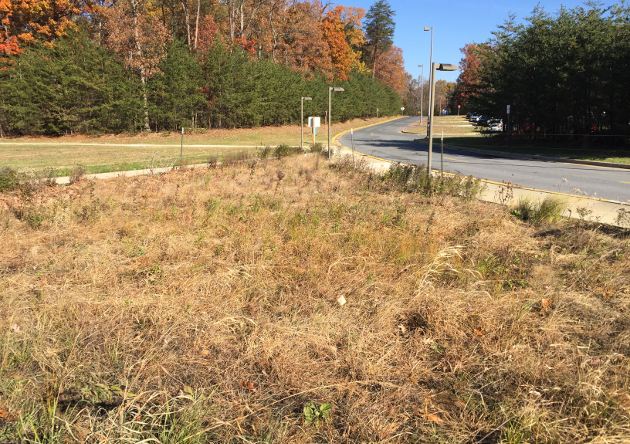
The cold snap we had a couple of weeks ago has finally spurred the meadow into hibernation. While there is still a tinge of green, various shades of brown now wash over the meadow. The occasional cricket may still make itself known, but the humming and thrumming of the pollinators has come to a standstill. They have gone off off to hunker down until everything re-emerges anew in the spring.
It's been an exciting year in the meadow, with all the native plants really beginning to show themselves and, in turn, welcome the diversity of insects, amphibians and birds that we've seen. This experiment has been magical and we can't wait to see what the next stage will bring. But, in the meantime, it's time for a well-deserved slumber.
October 19, 2017: It's getting late, but we're still open for business.
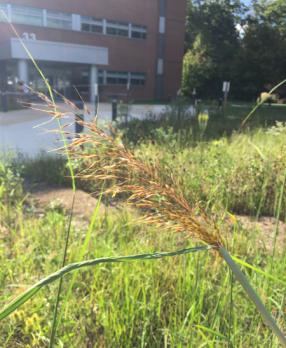 Mother Nature seems to have forgotten to change the seasons. Although the calendar is reading fall, the weather certainly seems more like summer. Some of the warm-season grasses, like the beautiful Indiangrass (Sorghastrum nutans) pictured at right, are soaking in the late summer sun and adding to the beauty of the meadow.
Mother Nature seems to have forgotten to change the seasons. Although the calendar is reading fall, the weather certainly seems more like summer. Some of the warm-season grasses, like the beautiful Indiangrass (Sorghastrum nutans) pictured at right, are soaking in the late summer sun and adding to the beauty of the meadow.
And while the weather is still mild, we continue to see several visitors in the meadow. The pollinators are continuing to drop by, as we still have several flowers in bloom. The black-eyed-susans seem to have gotten a second wind and are putting on a gorgeous display of black and gold. And, the polliators have noticed. In the photos below, you can see just a few of the ones we captured nectaring on the Maryland state flower: a transverse flower fly (left), bumble bee (center), and a hover fly (right).

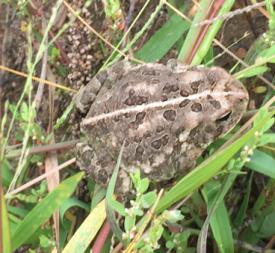 Finally, we also ran into this cute little guy (photo at left) while working in the meadow. At a quick glance, it appears to be an American toad. The abundance of wildlife in the meadow is so satisfying. By bringing back the plants that should be here, we also welcomed back all of the animals that rely on those plants. From caterpillars to butterflies to toads to even hawks, this meadow has it all. It's an example of a healthy, thriving ecosystem. And, one that we were able to create in a little patch of land here at Goddard.
Finally, we also ran into this cute little guy (photo at left) while working in the meadow. At a quick glance, it appears to be an American toad. The abundance of wildlife in the meadow is so satisfying. By bringing back the plants that should be here, we also welcomed back all of the animals that rely on those plants. From caterpillars to butterflies to toads to even hawks, this meadow has it all. It's an example of a healthy, thriving ecosystem. And, one that we were able to create in a little patch of land here at Goddard.
September 19, 2017: Weeds, Weeds, Go Away!
So, what is the number one reason that areas being restored to meadow ultimately fail? If you guessed weeds taking the place over, you'd be right. With all the efforts we've put into the meadow thus far, we're not about to let that happen. We've seen the benefits of the meadow already. If you've been following this blog, you're well aware of these benefits, too. Biodiversity is back in a big way, and pollinators, in particular. Monarchs are now calling this site home and entrusting their young to the bounties this area provides. Not to mention, every time we're out in the meadow, we have at least a few folks stop us and tell us just how much they love the meadow and appreciate all we're doing.
That's why we've been holding "meadow work parties!" It's never fun to weed alone... always weed with friends! We've had several volunteers come out and remove those most pesky and detrimental of weeds. So far, the main culprits are Japanese Clover (or common lespedeza) and foxtail (both the yellow and Giant varieties), though we certainly have a few others giving us headaches, as well. Feel free to peruse a great list of many of the common, local invasives. The Lespedeza, in particular, is an aggressive grower, out-competing our tiny, native seedlings as it spreads its way across the meadow in mat-like form. Removing just one plant, however, can have a huge effect (see below, where the left is before and the right is after removal).
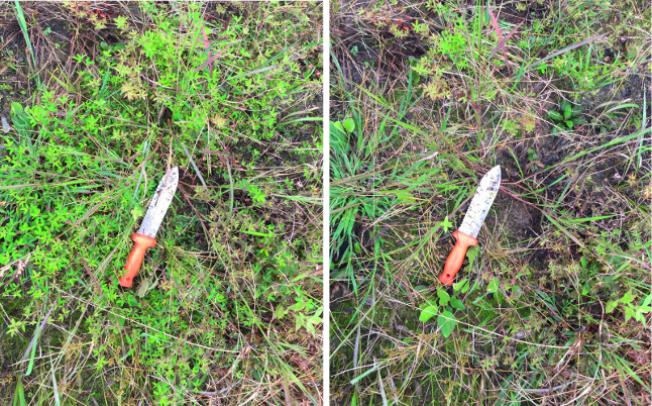
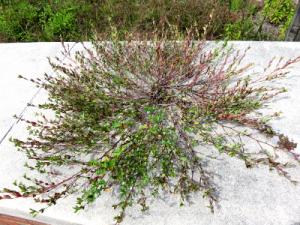 Viewed another way, at right is what just one lespedeza plant can look like. You read that right, this is just one plant! For scale, the plant is laying on the wall along the eastern edge of the meadow. The wall is about 2.5' wide, which means the diameter of this plant is roughly the same. You can see how leaving these invasives to grow unchecked could quickly result in disaster for the meadow. As a result, you'll see us out there in the coming weeks and again next year. The hope is after a couple full growing seasons, our natives will be firmly entrenched and will have established their territory, not giving any of these foreign invaders a chance.
Viewed another way, at right is what just one lespedeza plant can look like. You read that right, this is just one plant! For scale, the plant is laying on the wall along the eastern edge of the meadow. The wall is about 2.5' wide, which means the diameter of this plant is roughly the same. You can see how leaving these invasives to grow unchecked could quickly result in disaster for the meadow. As a result, you'll see us out there in the coming weeks and again next year. The hope is after a couple full growing seasons, our natives will be firmly entrenched and will have established their territory, not giving any of these foreign invaders a chance.
September 7, 2017: The more the merrier.
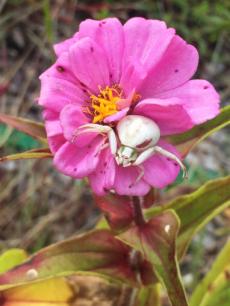 Dr. Sara comes to check on the meadow's progress nearly once a month. She visited today and while we were out there checking to see which new plants we could identify, we ran into quite a few little critters calling the meadow home. Pollinators are relatively easy to see, as they flit from flower to flower. But, if you look a little more carefully, you're bound to discover more secluded creatures in amongst the leaves and stems.
Dr. Sara comes to check on the meadow's progress nearly once a month. She visited today and while we were out there checking to see which new plants we could identify, we ran into quite a few little critters calling the meadow home. Pollinators are relatively easy to see, as they flit from flower to flower. But, if you look a little more carefully, you're bound to discover more secluded creatures in amongst the leaves and stems.
A great example is this female flower crab spider we found hanging out on a zinnia (picture at right). These webless spiders ambush pollinators from amongst the beautiful flowers on which they feed, making them highly effective predators. While we're not happy the pollinators are the victims, it's pretty exciting to know that the meadow is hosting such a wealth of pollinators that it can support these little killers.
We've documented the beautiful monarch caterpillar already a few times in this blog. But this picture (below) is fantastic if you look just a little harder. Notice in the crevice, that little creature that looks like a crab waving its arms to try and ward off the much larger caterpillar? Obviously, it's not a crab, but we're thinking another crab spider. This one, we're guessing, is a juvenile as it's much smaller than the female we noted above.
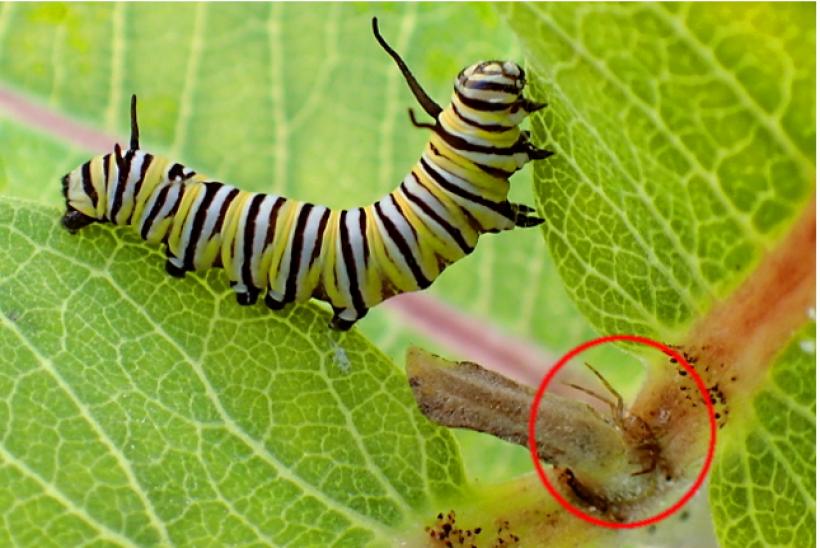
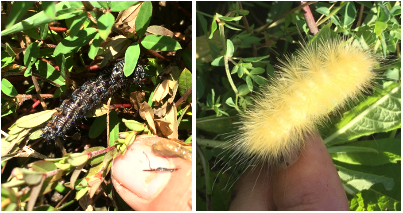 Also, while digging around in the leaves to remove invasives, we noticed quite a few other caterpillars. On the left is the buckeye caterpillar, which makes sense given how many buckeye butterflies we've seen in the meadow. We also spotted this fuzzy yellow fellow, known as the yellow woolly bear caterpillar (photo on right).
Also, while digging around in the leaves to remove invasives, we noticed quite a few other caterpillars. On the left is the buckeye caterpillar, which makes sense given how many buckeye butterflies we've seen in the meadow. We also spotted this fuzzy yellow fellow, known as the yellow woolly bear caterpillar (photo on right).
August 14, 2017: I saw (more of) the signs.
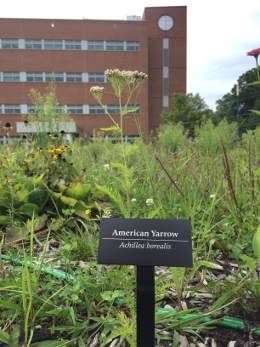 One of the most frequent questions we get from folks is, "What is that plant?!" For many of you, this is perhaps your first real introduction to native plants, so it's not surprising that you find most, if not all, of what's in the meadow very unfamiliar. In an attempt to help you get to know all of these natives a bit better, we have installed identification signs throughout the meadow. The signs have both the common name and the scientific name, as you may hear either one batted about in conversation. We attempted to put these close to the perimeter or along the path as best we could, so make sure you keep an eye out as you're passing by. And, if you see a plant without a marker and you're curious, remember you can always snap a quick photo and shoot us an email. We're happy to use our little meadow as a source of education, and make everyone more aware of the benefits of natives.
One of the most frequent questions we get from folks is, "What is that plant?!" For many of you, this is perhaps your first real introduction to native plants, so it's not surprising that you find most, if not all, of what's in the meadow very unfamiliar. In an attempt to help you get to know all of these natives a bit better, we have installed identification signs throughout the meadow. The signs have both the common name and the scientific name, as you may hear either one batted about in conversation. We attempted to put these close to the perimeter or along the path as best we could, so make sure you keep an eye out as you're passing by. And, if you see a plant without a marker and you're curious, remember you can always snap a quick photo and shoot us an email. We're happy to use our little meadow as a source of education, and make everyone more aware of the benefits of natives.
August 11, 2017: Erin is off.
Our summer intern, Erin, has left us in order to return to college and finish up her studies. She was wonderful and did such a nice job in initiating our documentation of pollinators and overall diversity in the meadow. We now have several weeks of data in the meadow versus turf grass, along with individual species counts. We will certainly miss her enthusiasm and efforts in all she did, but also wish her well in all her new adventures!

August 8, 2017: More monitoring... and maintenance.
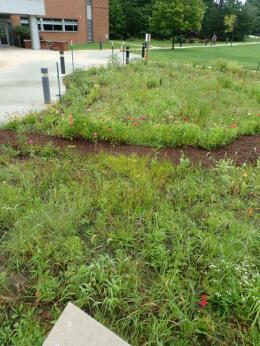 We were out in the meadow again today, checking in on how things are progressing. Dr. Sara was out there with us, making sure plants that should be there are, and plants that shouldn't be aren't. For the most part, the meadow is maturing just as well as we could have asked. Our native seedlings are everywhere, but they're still really small. Because they aren't mature, most of them will not flower this year. But, they are growing bigger and stronger. And, next year, and the year after, they are going to be amazing!
We were out in the meadow again today, checking in on how things are progressing. Dr. Sara was out there with us, making sure plants that should be there are, and plants that shouldn't be aren't. For the most part, the meadow is maturing just as well as we could have asked. Our native seedlings are everywhere, but they're still really small. Because they aren't mature, most of them will not flower this year. But, they are growing bigger and stronger. And, next year, and the year after, they are going to be amazing!
However, there are still improvements to make. Thus, you may have seen us slinging sand all over the place. Of course, it wasn't just sand. We were adding sulfur as the soil pH is still higher than the conditions native plants prefer. We also still have issues with soil compaction, so we decided to do a second year of the tillage radishes to try and break up the ground and give the roots of our wildflowers more room to grow.
Otherwise, things really are looking good. Just look at some of the great photos of all the wonderful things growing and thriving in the meadow. Below (left) is a gorgeous little flower on the pink fuzzybean plant. On the right, no, it's not a bee -- it's a transverse flower fly! Below that, another one of our beautiful monarch caterpillars resting on the underside of a swamp milkweed leaf. You can see he or she just enjoyed a snack of the leaf below. The meadow has a great foundation, so for now, we'll just sit back a bit and let you, and all the pollinators, just enjoy.

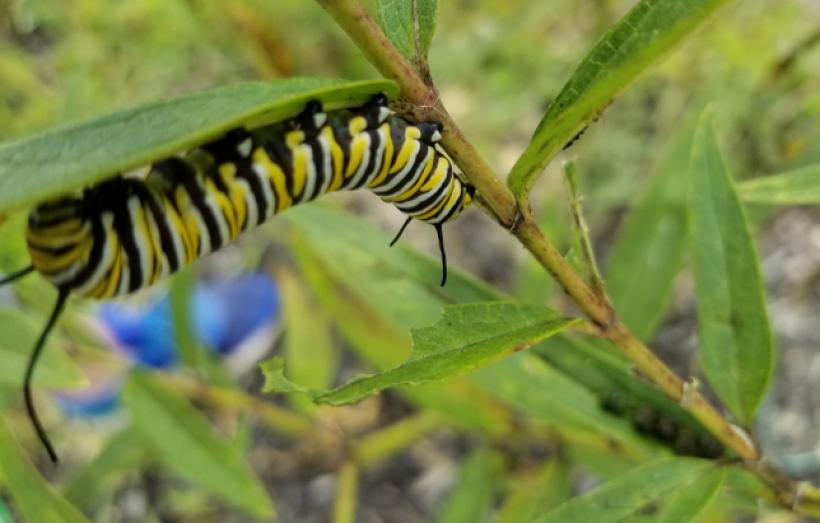
August 7, 2017: Well, Come on In!
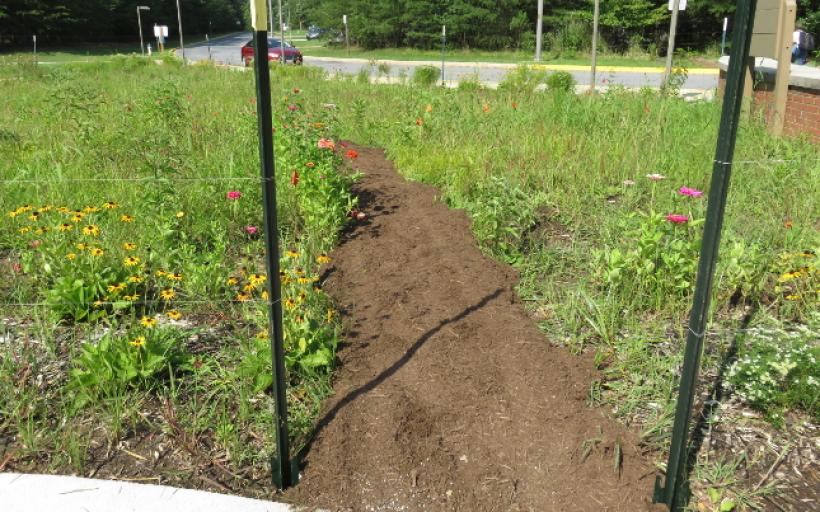
 The meadow is now officially open for business! We encourage you to come on in and get a close-up look at the meadow and all of its inhabitants. We've put some fresh mulch on the path to make it even more inviting. Please come and go as you like; however, we do ask that you stay on the path only, and also be sure to close the "doors" (see photo at left) behind you as we want to keep out the deer.
The meadow is now officially open for business! We encourage you to come on in and get a close-up look at the meadow and all of its inhabitants. We've put some fresh mulch on the path to make it even more inviting. Please come and go as you like; however, we do ask that you stay on the path only, and also be sure to close the "doors" (see photo at left) behind you as we want to keep out the deer.
Oh, and speaking of deer. You may have noticed a less than flowery aroma coming from the meadow recently. First, let us apologize for the smell. But, it is necessary. Despite our best efforts with the fishing line fence, we've seen evidence that the deer have been in the meadow and enjoying the native salad bar. We even have photographic evidence from some of the building occupants (see below). We are now trying some of the common deer/rabbit sprays to try and deter them from entering the meadow. We've had success in our home gardens, so hopefully we'll see the same here. But, it sure does smell terrible. Our recommendation... when it smells, go up-wind!
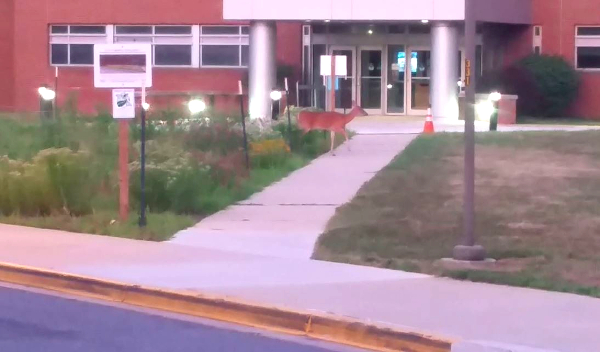
August 2, 2017: If you build it, they will come.
No, we didn't build a baseball field. We built a meadow. And it was built with the intention of welcoming back pollinators of all shapes and sizes. However, there was one particular pollinator we were really hoping to entice to our little meadow, and this week we found out they are here. The regal Monarch butterfly.
Yes, we had seen Monarch butterflies flit about from flower to flower, nectaring away (see photo on bottom left). But, would a female decide our meadow was the right place to lay her eggs and raise her young? We knew we had the right plants, milkweed. We actually have two species in swamp milkweed and common milkweed. But, just because you offer the plants doesn't mean a mama butterfly will lay her eggs. We are thrilled to report that two young Monarch caterpillars were spotted on the swamp milkweed during our last pollinator survey. You can see one (photo on bottom right) munching away on a flower bud, while many, many oleander aphids (little yellow creatures) look on.
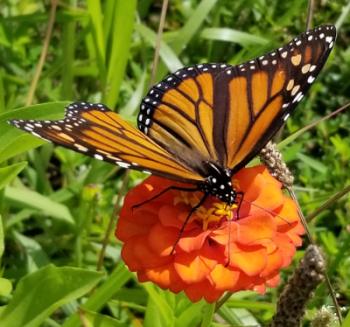
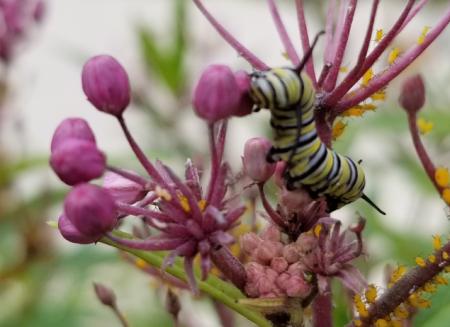
July 27, 2017: What ya looking for?
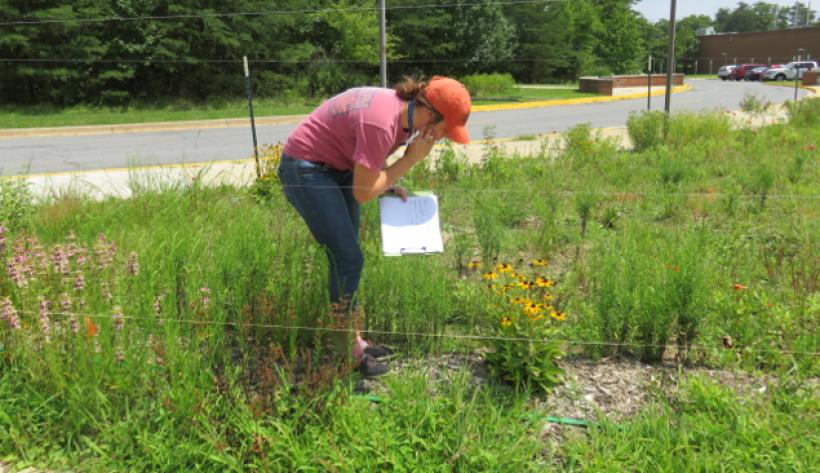
That's a question we've been asked quite a bit the last few weeks. As it turns out, we're looking for pollinators. We've been doing pollinator surveys in the meadow (that's our intern, Erin, in the picture above) and in the turf grass just adjacent to the meadow for comparison. To no one's surprise whatsoever, we're finding many more pollinators in the meadow. The grass does have the occasional insect (ant, leaf hopper, cricket, etc.) but the pollinators are few and far between.
Many folks are aware of the trouble honey bees have had of late. Their numbers are dropping significantly every year due to colony collapse disorder. However, our native bees are also stressed. And, it turns out, these native bees are a much better indicator of the health of the meadow. If you find several species and high numbers of these native bees, it's a good sign you're doing something right.
So, how does our meadow fare? Pretty darn good, actually. We're still performing surveys and likely will be for a while in order to capture the differences in seasons. Counts still need to be tallied as well, but the initial data indicate that the meadow is thriving. Just look at some of the pictures captured to get a taste for the diversity of creatures visiting this little oasis. This katydid (below) was caught hanging out on narrow-leaf mountain mint. The bumble below has a full pollen basket, or corbicula, on its hind leg.

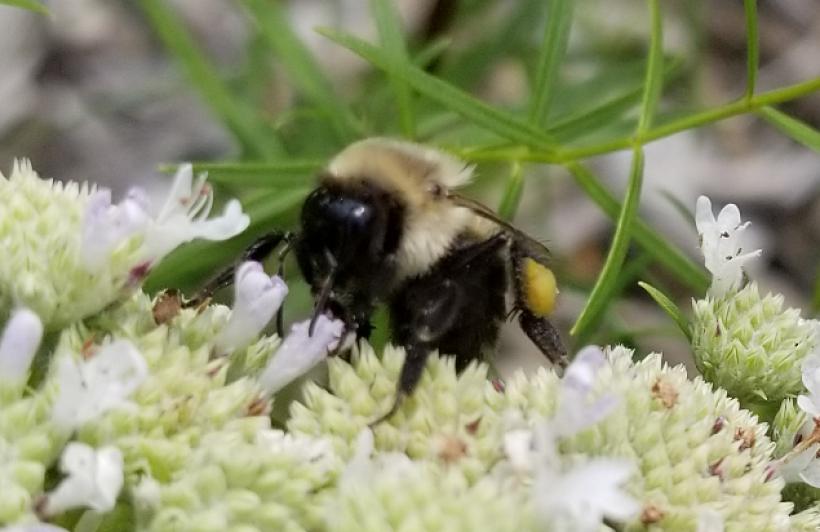
July 11, 2017: Our Summer Intern is Getting Up Close and Personal!
We have an intern working in our office for the summer, Erin Stephan. She's involved in a few projects but definitely has demonstrated an interest in our meadow. She spent some time out there last week getting up close and personal with the visiting fauna. She captured some amazing shots and we wanted to share them all with you. One of our favorites is this extreme close-up of a nectaring painted lady butterfly. To see more of her photos along with those of other employees, check out the employee photos section below.
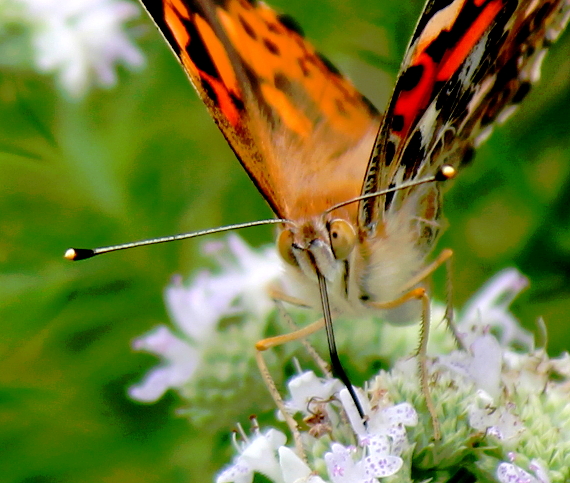
June 22, 2017: It's Pollinator Week - Did Anyone Let the Pollinators Know?
This week (June 19 - June 25) is Pollinator Week! With our meadow really starting to take shape, we thought we'd see who's coming to visit. We were able to snap a few photos of the bees and butterflies taking advantage of all the lovely blooming plants present in the meadow. A bumble bee on clustered mountain mint (left), a great spangled fritillary on swamp milkweed (middle), and a bumble bee and a skipper on narrow-leaf mountain mint (right) can be seen in the photos just below.
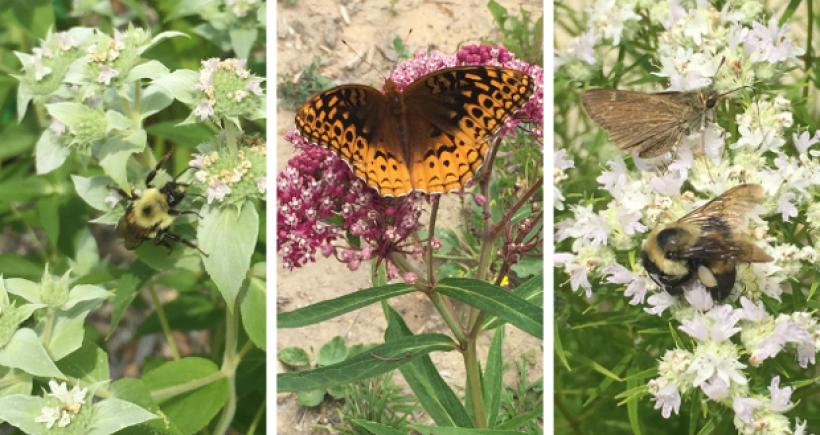
We are also happy to share some of our employee photos, as well. Lori Levine got this great shot of a bumblebee on narrow-leaf mountain mint. While we were thinking we'd get photos of only pollinators, Matt Thompson showed us that our fauna isn't limited to simply bees, butterflies and dragonflies. Biodiversity is continuing to increase and he proved it with this great photo of a (red-tailed?) hawk.

June 16, 2017: Well, what have we here?
 As we move from spring to summer, our meadow is starting to come into its own. The established plants in the border have come back with vigor and are blooming away. The seed which we sowed during the winter has germinated and is finally starting to come up in bunches. The blast of hot weather we've had over the last few weeks has really started to spur on our little babies (baby plants, that is). So, it was the perfect time to hold our next Master Gardener class, on monitoring and maintenance in the meadow.
As we move from spring to summer, our meadow is starting to come into its own. The established plants in the border have come back with vigor and are blooming away. The seed which we sowed during the winter has germinated and is finally starting to come up in bunches. The blast of hot weather we've had over the last few weeks has really started to spur on our little babies (baby plants, that is). So, it was the perfect time to hold our next Master Gardener class, on monitoring and maintenance in the meadow.
Our native plant expert, Dr. Sara, was back in action. She had flagged several species in the meadow for students to try and accurately identify. Were these "good" plants or "bad"? If the latter, should they be removed or could we simply let them stay? Students got out their field guides and thumbed through the pages to find the plant that matched.
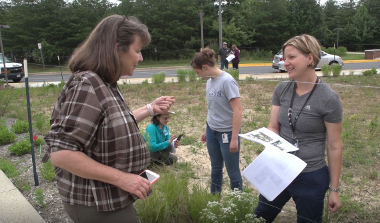 While you may not know it from simply looking at the interior of the area, our meadow is actually in pretty nice shape!
While you may not know it from simply looking at the interior of the area, our meadow is actually in pretty nice shape!
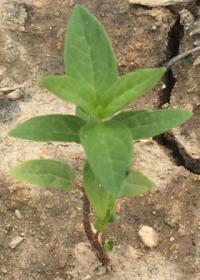 Patches do look bare... until you look a little more closely. Then you can see small leaves just poking out from the surface. And, once you spot a particular species, you start looking and find it has several neighbors right near by! Such is the case with this little swamp milkweed seedling (see photo at left) just getting started in the wettest portion of the meadow. Another good sign? We actually have very few weeds coming up. This shows us that the black plastic we used to cover the meadow last summer did a fairly good job of killing the weeds and weed seeds at the surface. We do still have weeds, of course -- it's not a perfect world. But, we really only have two species that Dr. Sara has termed "meadow killers." These are the weeds that will take over a meadow if left to their own devices. The Master Gardener students did a great job of removing the ones they spotted on this day, but we will have to remain vigilant to ensure they don't continue to rear their ugly heads.
Patches do look bare... until you look a little more closely. Then you can see small leaves just poking out from the surface. And, once you spot a particular species, you start looking and find it has several neighbors right near by! Such is the case with this little swamp milkweed seedling (see photo at left) just getting started in the wettest portion of the meadow. Another good sign? We actually have very few weeds coming up. This shows us that the black plastic we used to cover the meadow last summer did a fairly good job of killing the weeds and weed seeds at the surface. We do still have weeds, of course -- it's not a perfect world. But, we really only have two species that Dr. Sara has termed "meadow killers." These are the weeds that will take over a meadow if left to their own devices. The Master Gardener students did a great job of removing the ones they spotted on this day, but we will have to remain vigilant to ensure they don't continue to rear their ugly heads.
April 27, 2017: Monarchs officially welcome!
 You may have noticed a couple new signs in the meadow. These are to advertise the meadow's official designation as a Monarch Waystation as certified by Monarch Watch.
You may have noticed a couple new signs in the meadow. These are to advertise the meadow's official designation as a Monarch Waystation as certified by Monarch Watch.
In order to qualify as a Monarch Waystation, your area must demonstrate support for the entire lifecyle of the Monarch, with both the host plants for caterpillars as well as nectar plants for butterflies. With swamp milkweed and common milkweed in the meadow, we have the food source hungry caterpillars need in order to survive. Mother monarchs will only lay their eggs on milkweed plants. These milkweed plants also provide a nectar source when their flowers are in bloom. With the host of other wildflowers offered in the meadow, Monarch butterflies will come to feast on the necatar sources throughout the growing season.
February 7, 2017: Sowing the seeds.

|
It was another busy day in the meadow. We had roughly 30 of our Master Gardener and Master Naturalist friends come out on a balmy February day to help sow our native wildflower and grass seed. We had collected several different species over the late summer and fall from various locations on Center. Then our native plant expert, Dr. Sara Tangren, cleaned and stored them for us until the time was right for planting. She also determined the best location for each of the species to go in our meadow. Even though it's a relatively small area, the meadow has areas that are wetter, contain more organic matter, etc. than others across the site. She prepared maps for each species then set the MGs out on their own to sow the seeds. The seeds were mixed with sand to allow for a more even distribution when sowing the seeds (see photo to left). We also mixed in a bit of sulfur to lower the pH of the meadow soil which is higher than native plants typically prefer. After all of the MGs had spread their seed mixture, we took to garden rakes to lightly disturb the soil and ensure good contact between the seeds and soil (see photo below left). Finally, we used a roller to tamp down the area so that winds and rain won't carry away all of our hard work (see bottom photo). And now... more waiting. Mother Nature will do her thing over the next few weeks, bringing temperatures and precipitation which are out of our control. However, once the warmth and daylight are sufficient to awaken our little slumbering seeds, the magic will begin. And, we can't wait to see what happens.
|
February 2, 2017: Preparing the ground.
|
The time for sowing our meadow seeds is quickly approaching! We need to get the ground ready to try and give our little "babies" every advantage they can get. Therefore, we really needed to get the top layer of soil loosened up a bit. Doing this by hand with a garden rake would have been a lot of work. Don't work hard, work smart! We attached a rake on the back of our Gator and let this piece of equipment do much of the work for us. We also laid down a path in the meadow. This will afford visitors an easy way to get up close and personal with the meadow and all of its inhabitants. Come this summer, we're hoping you'll take a stroll through the meadow and be inspired by the vibrancy and vitality it has to offer. You will see extroardinary butterflies and moths flitting from flower to flower, hear the sounds of crickets and bees buzzing, smell the sweet aroma of flowers in bloom. Um, yeah, we're excited! |
|
January 4, 2017: Radishes are on the decline & that's just fine.

 The cold weather has finally come and put an end to our radishes. While they didn't quite reach the sizes we had hoped for, they certainly did grow large enough that they should have an impact on the soil condition in the meadow come this spring.
The cold weather has finally come and put an end to our radishes. While they didn't quite reach the sizes we had hoped for, they certainly did grow large enough that they should have an impact on the soil condition in the meadow come this spring.
Not all of our radishes were typical in shape or size. You can see from the picture below that some of them were definitely, let's say, unique. In any event, even this radish successfully did its job of breaking up the heavily compacted soils, creating voids and open spaces for future plant roots, as well as adding some much-needed organic material as it decays.
November 21, 2016: Just passing time.
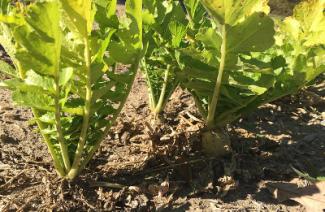 The radishes are in the ground and growing away. A couple have even been pulled (see below) to see just how big they are. Conditions vary across the meadow site, so some are bigger than others... but they are definitely growing!
The radishes are in the ground and growing away. A couple have even been pulled (see below) to see just how big they are. Conditions vary across the meadow site, so some are bigger than others... but they are definitely growing!
We've also been out and about collecting seed from various native wildflowers and grasses on Center. Now, we're just waiting. Waiting for Mother Nature to bring some persistent cold weather. Several consecutive days of hard cold will kill off our radishes. As the tubers die and break down, they will leave voids in the soil, filled with nutrient-rich material - the perfect environment for our little seeds to set up home in the spring. We will most likely set out the seed in January, as it will still require a cold period to set the internal clock such that it is ready to germinate come the warm weather of spring. So, until winter really sets in, we wait...
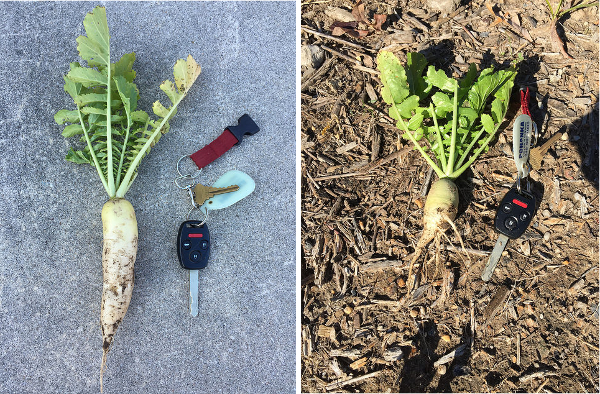
September 6, 2016: Oh, Dear. Deer.
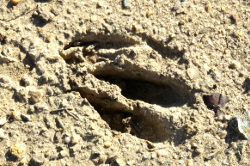 Looks like the pollinators weren't the only ones to notice that the black plastic was removed and radishes were planted. We found evidence of intruders of the hooved-kind (see photo at left). Yes,deer. We were hopeful that the proximity of the meadow to the building would keep them from coming around, but unfortunately, it seems that is not the case. And, as it turns out, deer really enjoy radishes. We mentioned these were tillage radishes, right? But, did we also mention they go by another name? Forage radishes. Yes, some folks plant them to actually attract the deer. So, not too surprising that the deer showed up.
Looks like the pollinators weren't the only ones to notice that the black plastic was removed and radishes were planted. We found evidence of intruders of the hooved-kind (see photo at left). Yes,deer. We were hopeful that the proximity of the meadow to the building would keep them from coming around, but unfortunately, it seems that is not the case. And, as it turns out, deer really enjoy radishes. We mentioned these were tillage radishes, right? But, did we also mention they go by another name? Forage radishes. Yes, some folks plant them to actually attract the deer. So, not too surprising that the deer showed up.
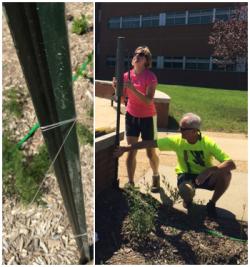 It seems just about every gardener in these parts has faced the wrath of the deer. It's hard to find a solution to this problem, so we did some research and came up with what we hope will work. You may have noticed we placed stakes along the perimeter of the meadow, then tied fishing line between the stakes. The fishing line is purposefully hard to see. The idea is that the deer will casually walk up to the salad bar, bump into the fishing line and get spooked! "Won't they just jump over it?" you ask. Hopefully not. Supposedly, deer will not jump over what they cannot see. Hence, no flagging or other sort of adornment on the fishing line to give away its presence. Of course, deer are persistent creatures. And if hungry enough, seemingly willing to defeat just about any deterrent. So, fingers crossed that this will do the trick. But, if you do happen to see them enjoying a radish snack, snap a photo and let us know we've been outwitted!
It seems just about every gardener in these parts has faced the wrath of the deer. It's hard to find a solution to this problem, so we did some research and came up with what we hope will work. You may have noticed we placed stakes along the perimeter of the meadow, then tied fishing line between the stakes. The fishing line is purposefully hard to see. The idea is that the deer will casually walk up to the salad bar, bump into the fishing line and get spooked! "Won't they just jump over it?" you ask. Hopefully not. Supposedly, deer will not jump over what they cannot see. Hence, no flagging or other sort of adornment on the fishing line to give away its presence. Of course, deer are persistent creatures. And if hungry enough, seemingly willing to defeat just about any deterrent. So, fingers crossed that this will do the trick. But, if you do happen to see them enjoying a radish snack, snap a photo and let us know we've been outwitted!
August 24, 2016: Seed Collecting Time.
 With all the preparation work that has gone into this meadow, you may be wondering when we're going to get around to putting in the actual meadow plants. With a shoestring budget like we have, we couldn't afford to purchase all the plants we'll need for our 0.1 acre, so that leaves us with having to seed the area. But, where do we get the seed? Well, from our wonderful native plants right here on Center. Along with our native plant expert, Dr. Sara Tangren (pictured at left), we went on a treasure hunt of sorts, searching for the native plants we'd like to introduce into our meadow. And, boy oh boy, did we make some amazing finds!
With all the preparation work that has gone into this meadow, you may be wondering when we're going to get around to putting in the actual meadow plants. With a shoestring budget like we have, we couldn't afford to purchase all the plants we'll need for our 0.1 acre, so that leaves us with having to seed the area. But, where do we get the seed? Well, from our wonderful native plants right here on Center. Along with our native plant expert, Dr. Sara Tangren (pictured at left), we went on a treasure hunt of sorts, searching for the native plants we'd like to introduce into our meadow. And, boy oh boy, did we make some amazing finds!
We toured the whole center, including the external areas (Areas 100, 200, 300 and 400), looking for native grasses and wildflowers that would do well in our meadow. We found all sorts of great plants, including narrow-leaf mountain mint, gray goldenrod, shaggy blazingstar, purple top grass, Indian grass, fringed sedge, grass-leaved goldenrod, New York ironweed, Coastal Joe Pye weed, and so many, many more! We collected seed from those plants already in seed, careful not to take more than we need, and will come back a few more times in the future to catch those species that will be maturing as we move into the fall.
We also found some visitors on these plants (see below) that we hope will eventually find their way to the B33 meadow. Actually, some of these guys have been spotted at our new little meadow, with the pictures to prove it sent in from some close-observing employees. Please feel free to send us your photos, too.
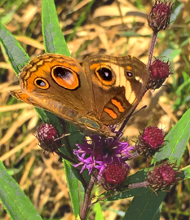 Common buckeye on ironweed |
 Monarch on swamp milkweed |
 Skipper on black-eyed susan |
August 17, 2016: We Have Radishes!
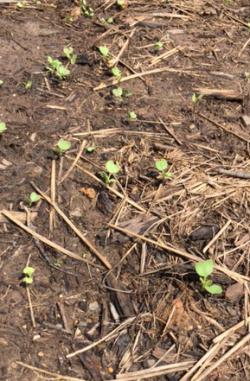 The hot and steamy days of the last week, along with the consistent showers in the late afternoon and evening have made for some pretty ideal growing conidtions for our radishes. You can see the seedlings coming up in the photo at left. These little guys will continue to grow bigger and deeper over the next few months, finally dying off when we have our first several consecutive days of hard frost. By then, the radishes will have drilled up to three feet below the soil surface, breaking up the extremely compacted soil we have in the B33 meadow.
The hot and steamy days of the last week, along with the consistent showers in the late afternoon and evening have made for some pretty ideal growing conidtions for our radishes. You can see the seedlings coming up in the photo at left. These little guys will continue to grow bigger and deeper over the next few months, finally dying off when we have our first several consecutive days of hard frost. By then, the radishes will have drilled up to three feet below the soil surface, breaking up the extremely compacted soil we have in the B33 meadow.
August 10, 2016: Weeds Be Gone! Welcome Radishes!
|
Today was a busy day in our little meadow. We held Class #2 with our Master Gardener and Master Naturalist friends, with the goal of finishing up the site preparations.
Step 1 was pulling up the black plastic that had been in place during these hot summer months. We pulled up the staples and rolled the plastic, to reveal an area devoid of any living plants -- just what we wanted (see photo below). All those weeds that had been in the meadow were killed by baking in the heat trapped under the plastic. In fact, temperature readings were taken several times during the summer with the hottest measurement in excess of 115° F! |
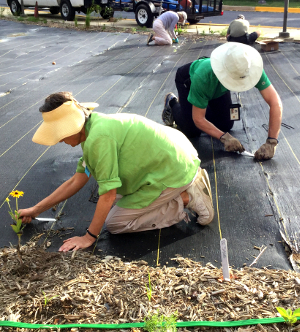 |
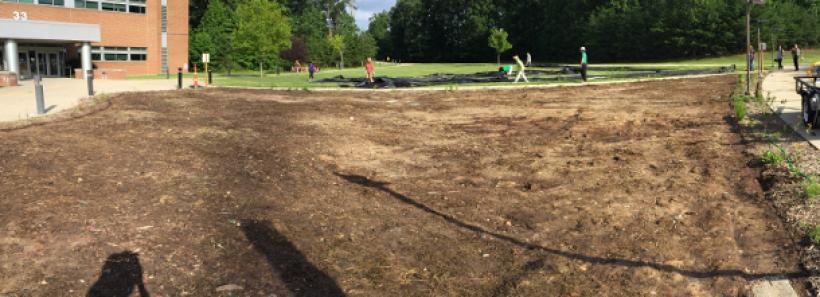
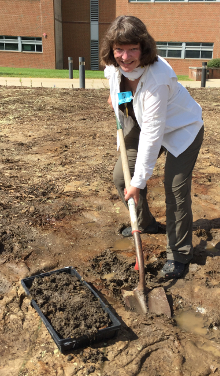 As a way of testing how effective the plastic was at killing weed seeds, we collected soil samples from different locations in the meadow and out. We will put these in the greenhouse and see what grows. Hopefully those areas under the plastic have much less growing than other areas. You can see Sara hard at work taking a soil sample in the photo at right.
As a way of testing how effective the plastic was at killing weed seeds, we collected soil samples from different locations in the meadow and out. We will put these in the greenhouse and see what grows. Hopefully those areas under the plastic have much less growing than other areas. You can see Sara hard at work taking a soil sample in the photo at right.
Step 2 was adding some soil amendments to improve conditions in preparation for seeding with native grasses and wildflowers later this year. From soil tests conducted earlier this spring, we determined the soil pH is too high for native species accustomed to this area. This is likely due to the adjacent sidewalks which are comprised of more basic materials and can then leach to the meadow area. As a result, we added sulfur powder and ferrous sulfate to lower the pH to a more preferred level.
 To address the issue of soil compaction, we also decided to grow forage radishes. These radishes have an extremely strong tap root which bores into the ground, breaking apart the soil and creating voids and spaces which make for ideal growing conditions.
To address the issue of soil compaction, we also decided to grow forage radishes. These radishes have an extremely strong tap root which bores into the ground, breaking apart the soil and creating voids and spaces which make for ideal growing conditions.
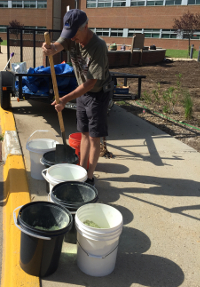 We mixed the radish seeds with the two types of sulfur and some sand as a medium for the mixture in several buckets (see photo below). Next, we spread the contents of the buckets mixing the amendments in buckets throughout the meadow area to get even coverage.
We mixed the radish seeds with the two types of sulfur and some sand as a medium for the mixture in several buckets (see photo below). Next, we spread the contents of the buckets mixing the amendments in buckets throughout the meadow area to get even coverage.
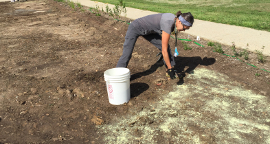
Now, we wait. With moisture and heat from our late-August weather, hopefully these seeds will quickly germinate and continue growing until the first hard frost of the cool season. And then, finally, we are ready to plant our meadow grass and wildflower seed!
June 13, 2016: Pollinator Week is Coming Up - Tell Us What You See!
 Pollinator Week is coming up June 20-26. With our new meadow starting to take shape, you've probably noticed some pollinators coming to visit. We captured this blurry picture of a bumblebee visiting one of the beardtongue plants (see photo to right) just a day after it was planted! It's true - if you build it, they will come!
Pollinator Week is coming up June 20-26. With our new meadow starting to take shape, you've probably noticed some pollinators coming to visit. We captured this blurry picture of a bumblebee visiting one of the beardtongue plants (see photo to right) just a day after it was planted! It's true - if you build it, they will come!
If you happen to see bees, butterflies, or any other type of pollinator at the meadow or elsewhere on Center, please take a picture and send it to us!
June 10, 2016: I Saw the Signs.
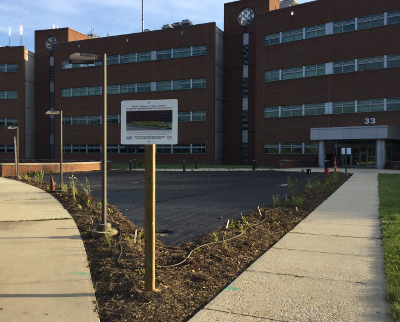 You may have noticed signs are now up in the meadow. As we've been out there working, many folks have stopped by to ask us what we're doing, why the plastic is there, or any other number of questions. We thought having signs to explain what's going on would be helpful, and of course, we included a URL which may have been what brought you to reading these words right now. Hopefully this page has answered any questions you may have, however, if you didn't find all the answers you were seeking, please contact Darlene or Janine.
You may have noticed signs are now up in the meadow. As we've been out there working, many folks have stopped by to ask us what we're doing, why the plastic is there, or any other number of questions. We thought having signs to explain what's going on would be helpful, and of course, we included a URL which may have been what brought you to reading these words right now. Hopefully this page has answered any questions you may have, however, if you didn't find all the answers you were seeking, please contact Darlene or Janine.
June 2, 2016: Plants are Growing. Weeds are Baking.

The meadow is now "done" for this spring/summer. If you've been out to the site, you'll notice several rows of plastic laid down in strips to cover the entire center of the meadow area. The number one reason a new meadow fails is because of weeds. Thus, the area needs to be free of all weeds and all the millions of weed seeds already contained in the soil. While there are several ways to accomplish killing the weeds and weed seeds, we wanted to avoid the use of pesticides at all costs. We also were severely limited in terms of budget, so were not able to get the top six inches of soil (where all those weed seeds reside) removed from the site. The next best option is to use plastic to essentially cook all of the seeds and render them no longer viable.
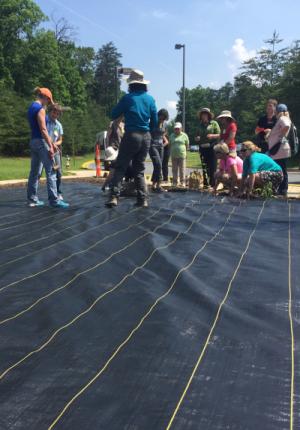 We welcomed a class of roughly 20 Master Gardeners and Master Naturalists to Goddard on June 1. Dr. Tangren led the class on the basics of preparing the soil for a meadow, including ways to deal with the weed seed bank. Then we headed out to the site to get our hands dirty (see photo). The MGs/MNs got to work and successfully laid down plastic over the entire central portion of the meadow to start the "baking" process. This plastic is sturdy enough to withstand deer hooves, and should do an excellent job at retaining our summertime heat.
We welcomed a class of roughly 20 Master Gardeners and Master Naturalists to Goddard on June 1. Dr. Tangren led the class on the basics of preparing the soil for a meadow, including ways to deal with the weed seed bank. Then we headed out to the site to get our hands dirty (see photo). The MGs/MNs got to work and successfully laid down plastic over the entire central portion of the meadow to start the "baking" process. This plastic is sturdy enough to withstand deer hooves, and should do an excellent job at retaining our summertime heat.
Our wonderful volunteers, housed primarily in B33, are doing a great job of care taking for the new little plants. When Mother Nature does not cooperate, they have been watering to help the new plants get established. There will also be the occasional weed-pulling needed, but this should be minimized with the landscaping paper we put down.
We will be installing signs over the next couple of weeks to help educate employees and other visitors to the site. Otherwise, our work is done until mid-August... stay tuned for that!
May 27, 2016: The Border's in. Bring on the Plastic!
|
Things are starting to come together! Thanks to the help from a lot of volunteers in the building, we were able to get the border area planted. Not only did we get help putting down landscape paper (see photo to the right), applying mulch and planting flowers, we also got several donations of plants! We have some small signs up in the meadow to show you what is growing, but we've also got a complete list.
|
Folks came out in numbers to take advantage of the great weather and to lend a helping hand. Over two days, we were able to lay down and stake landscape fabric along the entire border area. This will help to control any weeds looking to pop up amongst our new plants. We also were able to cover that area with several cubic yards of mulch to help retain moisture and prevent weeds. Finally, close to 100 plants were lovingly placed in their new homes. It was a lot of work but our volunteers were fantastic! We even had Dot Zukor come out and lend a hand - thanks again to all!
|
With the border planted, we're ready for the next phase of meadow development - laying down the plastic middle. Next week, we'll have our Maryland Master Gardeners and Master Naturalists out to oversee this crucial step. This will be the first class in a series of classes organized by the University of Maryland Extension that will cover the basics of meadow creation. For this step, the black plastic will trap heat during the growing season (June through August) and "bake" every living thing under there, including weeds and weed seeds stockpiled in the soil. If you see us out there on June 1, make sure to stop by and say "hello"!
May 19, 2016: Sod's Removed. Let's Get Planting!
 The transition to self-sustaining meadow will not be an overnight process. The area will go through several stages to ensure its ultimate success. Currently, we have cleared the area of a few remaining strips of turf grass. These border areas, already having a strong foothold, could have encroached into the meadow and crowded out desirable plants. Over the coming weeks, we will begin installing landscaping fabric and planting the first of many plants in the area.
The transition to self-sustaining meadow will not be an overnight process. The area will go through several stages to ensure its ultimate success. Currently, we have cleared the area of a few remaining strips of turf grass. These border areas, already having a strong foothold, could have encroached into the meadow and crowded out desirable plants. Over the coming weeks, we will begin installing landscaping fabric and planting the first of many plants in the area.
Ultimately, it is hoped that this project will serve as a model for additional areas throughout the Center, where the conversion from turf grass to meadow is feasible. Moving to more sustainable landscapes is vital to ensuring that pollinator health actions have longevity and lead to continuing improvements in pollinator habitat.6
Check back for frequent updates to this page or, for more information, please contact the project leads listed below.
January 13, 2016: The Mud Pit.
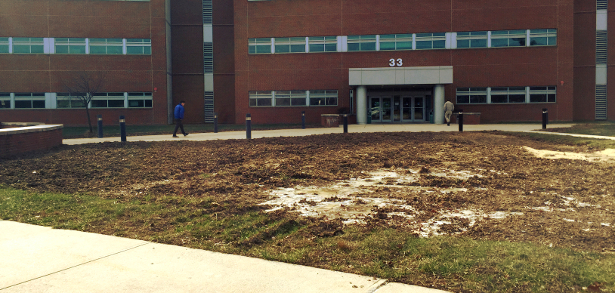
This is the not-so-affectionately named "mud pit". It's the area in front of B33 that once had various ornamental grasses and other random plants growing in it. In an effort to tighten down on grounds maintenance costs, the area had all of the vegetation removed in the fall of 2015. Then the winter hit and the area became known as the mud pit. While the area was targeted for seeding with turf grass in the spring of 2016, Code 250, the Medical and Environmental Management Division, stepped in to see if there wasn't a better solution. And, the Meadow Demonstration was born.
A Call to Support Sustainability & Diversity
In recent years, several policy guidelines have directed Federal agencies to adopt more sustainable operations, including landscaping practices to create and protect habitat that supports the threatened status of pollinators, particularly bees and butterflies.1 Federal facility managers are instructed to actively examine their current buildings, grounds, and practices for opportunities to transition to a richer diversity of pollinator-friendly plant species, improving the sustainability of Federal landscapes.2 A 2014 Presidential Memorandum directs Federal agencies to take immediate measures to support pollinators through sustainable practices such as planting pollinator-friendly vegetation, increasing flower diversity in plantings, and limiting mowing acreage.3
Native Meadows: The Best "Lawn"
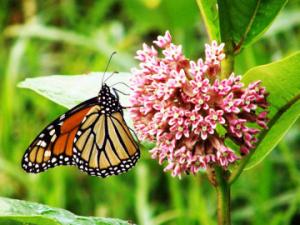 Landscaping an area with conventional turf grass is a common practice in this country. However, grass requires frequent warm-weather mowing and creates extremely poor habitat incapable of sustaining a diverse population of wildlife. Our plan is to alternatively transform this area into an aesthetically pleasing, ultimately very low-maintenance (requiring only one mowing per year) area of native vegetation that will support several species of pollinators, including Monarch butterflies by incorporating Milkweed which is critical to their survival.3 Conversion to meadow will also result in stormwater management benefits. Compared to a conventional lawn planting, native vegetation found in meadows has stronger and denser root and stem systems. This leads to a greater volume of water uptake (evapotranspiration), improved soil conditions through organic material and macropore formation, and greater infiltration, culminating in decreased runoff of the area.4
Landscaping an area with conventional turf grass is a common practice in this country. However, grass requires frequent warm-weather mowing and creates extremely poor habitat incapable of sustaining a diverse population of wildlife. Our plan is to alternatively transform this area into an aesthetically pleasing, ultimately very low-maintenance (requiring only one mowing per year) area of native vegetation that will support several species of pollinators, including Monarch butterflies by incorporating Milkweed which is critical to their survival.3 Conversion to meadow will also result in stormwater management benefits. Compared to a conventional lawn planting, native vegetation found in meadows has stronger and denser root and stem systems. This leads to a greater volume of water uptake (evapotranspiration), improved soil conditions through organic material and macropore formation, and greater infiltration, culminating in decreased runoff of the area.4
We tried to select native meadow plants that would do well given the conditions of the site. This includes full sun exposure, relatively poor, compacted soils, and highly variable moisture conditions. We also selected species specifically that are hosts for Monarch butterflies (swamp milkweed and common milkweed, both in the milkweed family). Here is a list of all the native plants you will find in the meadow.
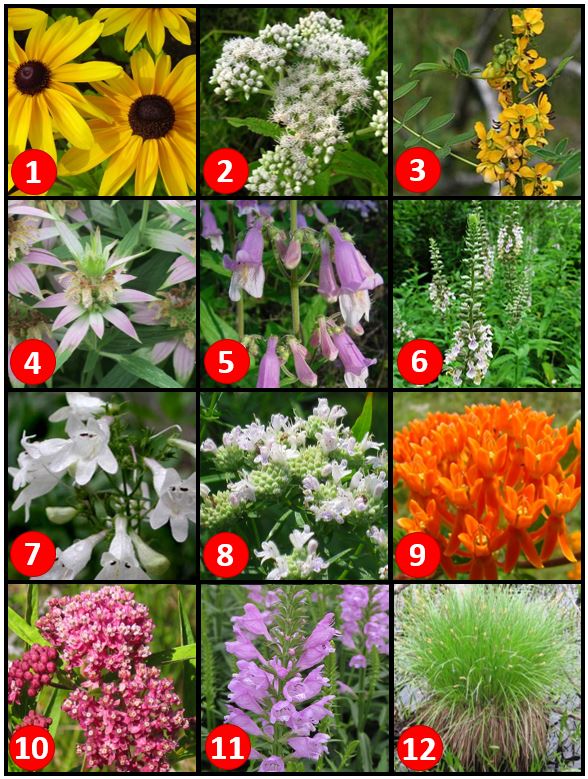
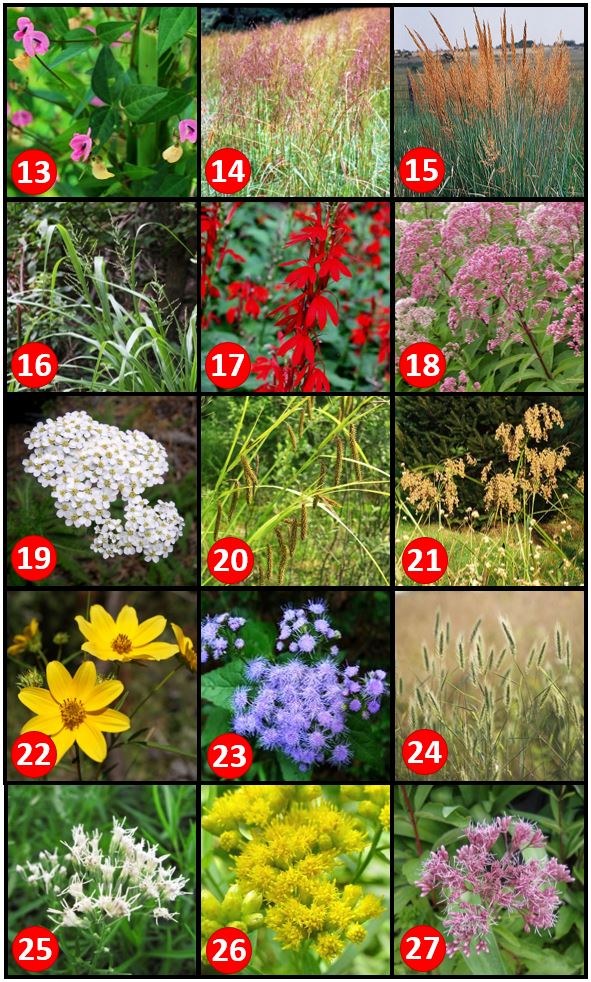
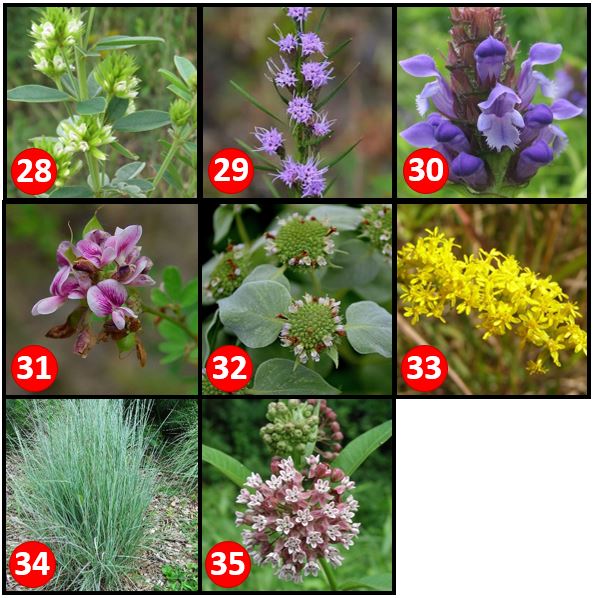
1. Black-Eyed Susans (Rudbeckia hirta)
2. Boneset (Eupatorium perfoliatum)
3. Maryland Senna (Senna marilandica)
4. Spotted Beebalm (Monarda punctata)
5. Hairy Beardtongue (Penstemon hirsutus)
6. American Germander (Teucrium canadense)
7. Foxglove Beardtongue (Penstemon digitalis)
8. Narrow-Leaf Mountain Mint (Pycnanthemum tenuifolium)
9. Butterfly Weed (Asclepias tuberosa)
10. Swamp Milkweed (Asclepias incarnata)
11. Obedient Plant (Physostegia virginiana)
12. Tussock Sedge (Carex stricta)
13. Pink Fuzzybean (Strophostyles umbellata)
14. Purpletop Grass (Tridens flavus)
15. Indiangrass (Sorghastrum nutans)
16. Beaked Panicgrass (Panicum anceps)
17. Cardinal Flower (Lobelia cardinalis)
18. Joe-Pye Weed (Eutrochium fistulosum)
19. American Yarrow (Achillea borealis)
20. Fringed Sedge (Carex crinoides)
21. Woolgrass (Scirpus cyperinus)
22. Tickseed Sunflower (Bidens polylepsis)
23. Mistflower (Conoclinium coelestinum)
24. Virginia Wildrye (Elymus virginicus)
25. Hyssop Thoroughwort (Eupatorium hyssopifolium)
26. Grass-Leaf Goldenrod (Euthamia graminifolia)
27. Coastal Joe-Pye Weed (Eutrochium dubium)
28. Round-Head Bushclover (Lespedeza capitata)
29. Shaggy Blazingstar (Liatris pilosa)
30. Self Heal (Prunella vulgaris)
31. Virginia Bushclover (Lespedeza virginica)
32. Clustered Mountainmint (Pycnanthemum muticum)
33. Gray Goldenrod (Solidago nemoralis)
34. Little Bluestem (Schizachyrium scoparium)
35. Common Milkweed (Asclepias syriaca)
While not native, we've also added zinnias to help out the pollinators and look beautiful these first few growing seasons.
Partnership
Having little experience in the area of sustainable landscapes, Goddard sought out assistance in making this plan a reality. Dr. Sara Tangren, a native plant expert, has collaborated with us on past projects such as native plant rescues, so we reached out to her once again. Dr. Tangren is the lead trainer for the University of Maryland Extension Service (UMDES) Master Gardener and Master Naturalist program. She saw this as a golden opportunity to teach her students about creating a native plant meadow, using our site for practicum classes. Collaboration with the UMDES also supports the Presidential Memorandum to seek technical assistance through collaboration with the land-grant university-based cooperative extension services.5
For a little more insight into Dr. Tangren's professional life and how she got to where she is, please consider watching the Maniac Lecture she gave on April 20, 2017.
Employee Photos
Many employees have noticed the bees, butterflies, moths, and other creatures that have returned to the area since the meadow went in. If you spot something, please take a picture and send it to us and we will post it here.
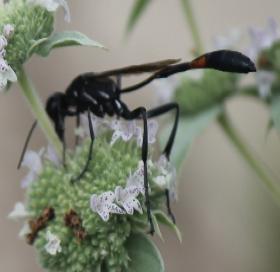 Thread-waisted wasp (Erin Stephan - 7.5.2017) |
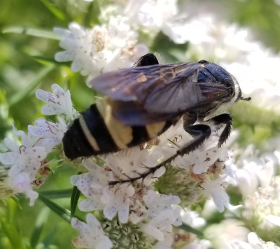 Scoliid wasp (Erin Stephan - 7.5.2017) |
 Clouded sulphur (Erin Stephan - 7.5.2017) |
 Calico pennant (Erin Stephan - 7.5.2017) |
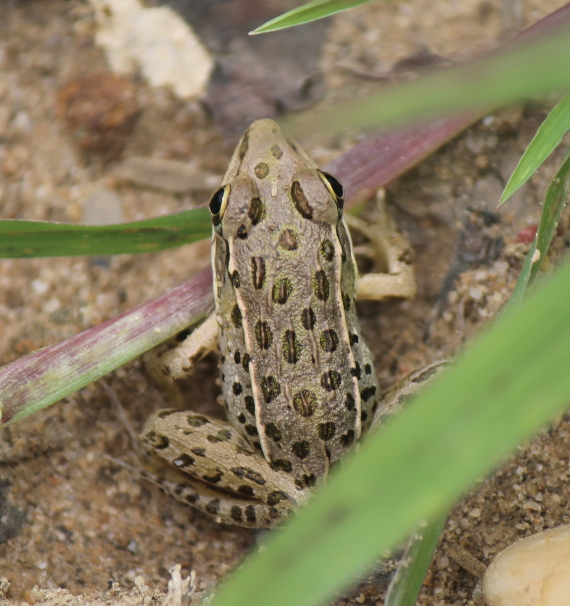
Southern Leopard frog (Erin Stephan - 7.5.2017)
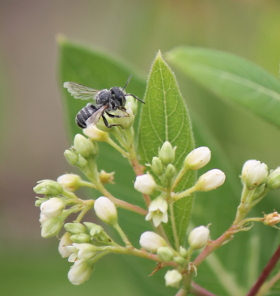 Flat-tailed leaf-cutter bee (Erin Stephan - 7.5.2017) |
 Gray Hairstreak (Erin Stephan - 7.5.2017) |
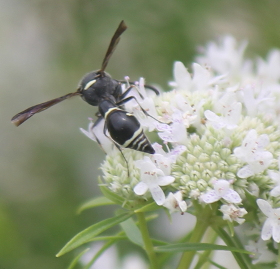 Potter wasp (Erin Stephan - 7.5.2017) |
 Long-legged fly (Erin Stephan - 7.5.2017) |
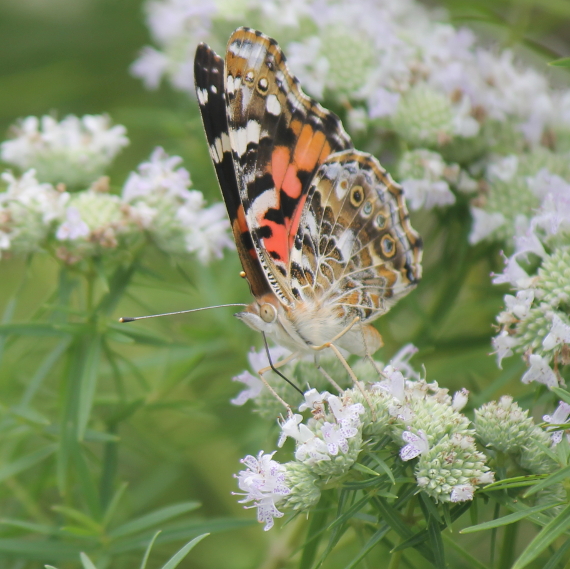
Painted Lady butterfly (Erin Stephan - 7.5.2017)
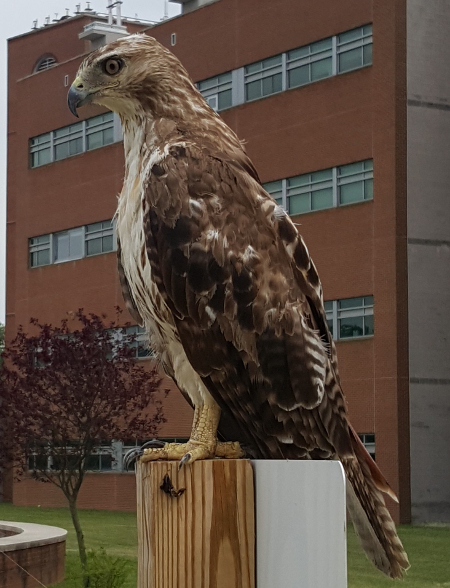
Red-tailed hawk overlooking the meadow (Eric Wingard - 6.22.2017)
 Buckeye and variegated fritallary on butterfly milkweed (Tom Nolan - 8.31.2016) |
|
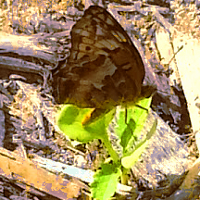 Varigated fritallary on tillage radish |
 Sachems (females) on zinnia |

Skipper on (?) a black swallowtail on zinnia
FAQ
See a list of the most common questions employees ask us about meadows. If you still have a burning question, send us an email and let us know what's on your mind!
References
- Supporting the Health of Honey Bees and Other Pollinators, October 2014
- Guidance for Federal Agencies on Sustainable Practices for Designed Landscapes, October 2011
- Pollinator-Friendly Best Management Practices for Federal Lands, May 2015
- Pennsylvania Stormwater Best Management Practices Manual, 2006
- Presidential Memorandum - Creating a Federal Strategy to Promote the Health of Honey Bees and Other Pollinators, June 2014
- National Strategy to Promote the Health of Honey Bees and Other Pollinators, May 2015




